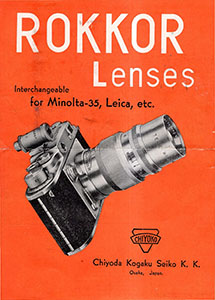Minolta 35
... and now for something completely different,
the Leica re-imagined
.jpg)
Contents
(Scroll down or click on Links)
Is it a Copy?
The Company
Chiyoda's Distributors
The 35mm Format Wars
Japanese vs Leica Format
The 0.5 mm Debate
Minolta 35 Model IIB Frame Size
The Minolta 35 mm Camera
About the Lens Choice
The Rangefinder/Viewfinder Compromise
Viewfinder Window
Flash Synchronisation
Made in Occupied Japan, Other Markings & Labels
Models
Models Table
Model A
Model B
Model C
Model D
Model E
Model F
Model IIModel II, type a1
Model II, type a2
Model II, type b1
Model II, type b2
Standard Lenses Table
Chiyoko Super Rokkor f/2.8 45 mm
Chiyoko Super Rokkor f/2 5 cm (option)
Chiyoko Super Rokkor f/2.8 5 cm (option)
Chiyoda Kogaku Super Rokkor f/1.8 5cmAccessory Lenses - First Edition
Chiyoko Super Rokkor f/2.8 8.5 cm
Chiyoko Tele Rokkor f/5.6 11 cm
Chiyoko Tele Rokkor f/4 13.5 cm
Chiyoko Rokkor f/3.5 3.5 cm
Mystery Lenses Circa 1951, Probably UnreleasedAccessory Lenses - Second Edition
Minolta Rokkor Lens Codes
Minolta Tele. Rokkor QE f/3.5 100 mm
Minolta W.Rokkor QF f/1.8 35 mmAccessory Lenses - Third Edition
Minolta Macro Rokkor QF f/3.5 50 mm
Minolta G-Rokkor 28 mm f/3.5
Lens Caps
Ever-ready and Lens Cases
Filters
Lens HoodsReloadable Film Cassettes
Minolta Auto-Up Close-up Lens & Rangefinder Attachment
Flashguns
Enlarger
Slide Projector
From Chiyoda Kōgaku to You - Boxes
Other Minolta 35 mm Interchangeable Lens Rangefinder Cameras
SKY and Model III Prototypes
Minolta A Series
Is it a Copy?
Many of the fans and collectors of the Minolta 35 insist that it is “inspired by” Leica rather than a copy. If it went on sale today, we would probably call it “Leica compatible”. Nevertheless, as we saw on the Leica Copies Japan page, collectors, historians and authors such as HPR and Pont and Princelle like to categorise and use certain criteria, not always agreed amongst themselves, to determine whether a camera is a Leica copy or not. In this context, the visual appearance and technical design solutions are secondary at best and maybe even immaterial. The basic criteria are:
- Use of 35 mm film and 24 x 36 mm negative frame sizes.
- Lens mount 39 mm in diameter with a Whitworth thread pitch of 26 turns per inch and a 28.8 mm lens flange to film distance.
- The shutter must be focal plane.
The opening back and combined viewfinder/rangefinder are certainly usability enhancements, in 1947 a better Leica, but the top plate still has the Leica look and it operates like one.
My take is that the 1947 model would still clearly be a Leica copy to a collector except that it stumbles at the first hurdle, it has a frame size of 24 x 32 mm (3 x 4 format). So certainly inspired by the original, but nevertheless also only a near copy. Whilst over time the frame grew slightly wider, many websites and books claim that the Model IIB finally adopted the 24 x 36 mm frame size in 1958, thereby actually becoming a copy in collectors' terms. Only that never happened, there never was an increase to 24 x 36 mm - see The Format Wars below.
The Company
(Unlike Leotax, Nicca and Yashica, the Minolta story has been been well documented in many places and I have little to add to the understanding of the company and its other models. This section is a broad overview to provide some background which I think is relevant for the release of the Minolta 35 and to contrast the company's fortunes with the other copy makers and the other company that it shared some parallels with, Yashica/Kyocera. Both were TLR makers as well as makers of Leica copies, both had later links with iconic German camera companies and both exited the photographic market at a similar time and for similar reasons.)
The company that made the Minolta 35 LTM rangefinder camera was called Chiyoda Kōgaku Seikō, only itself becoming Minolta Co., Ltd., in 1962. It was founded as Nichi-Doku Shashinki Shōten, translated as Japanese-German Camera Shop, in November 1928 in what is modern day Nishinomiya City, halfway between the cities of Osaka and Kobe in Japan, by young entrepreneur, Kazuo Tashima (the original factory and headquarters, located near the Mukogawa River, was known as the Mukogawa plant). He was born on 20 November 1899 and retired as President in 1982 after leading the company for 54 years. He then became the Chairman of the company until he died on 19 November 1985. He was succeeded as President by his eldest son, Hideo Tashima, so it was very much a family dynasty and the vision of one man which guided the company. Kazuo Tashima as a young man and later in life, in about 1963:
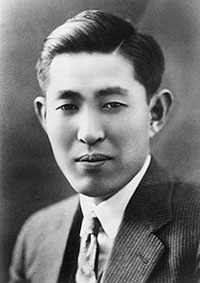
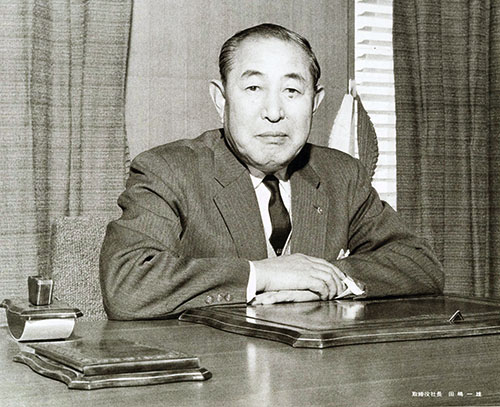
From the Konica Minolta global website:
“On November 11, 1928, the company that would be known as Minolta in later years opened its first factory in present-day Nishinomiya City, Hyogo Prefecture. The founder, Kazuo Tashima, who worked for an ad agency in Tokyo after graduating from university, returned to his hometown after Tokyo was hit by the Great Kanto Earthquake. During a visit to Europe, he discovered the great possibilities of optical equipment, which made him decide to start a company upon his return to Japan.”
The visit to Europe was to represent his father's import and export company on a government backed silk promotion trade mission to Paris. While there, Kazuo toured a factory producing high grade optics. He believed that could be done in Japan too. His father wasn't supportive but he managed to borrow funds from the chief clerk of his father's business.
The Japanese photographic industry was still at a very early and basic stage of development and Kazuo Tashima recognised that to make rapid progress, he and his facility would need assistance so he recruited two German camera technicians/engineers to work with him, Billy Neumann & Willie Heilemann, who had previously worked at E. Krauss, a French camera and lens maker. Initially, lenses and shutters were imported from Germany and the cameras were based on German designs, hence the reference to Japanese-German Camera Shop in the name.
The first camera, called the Nifcarette (embossed into the leatherette in Roman characters, the sometimes quoted “Nifcalette” is a translation error) was released in 1929 and was a folder taking 4 x 6.5 cm images on 127 film. “Nifca” was a combination of an acronym, which Kazuo Tashima seemed to have a liking for, of “Nichi, or Nippon, Foto Cameras” and “ette” meaning small. “Nichi” and “Nippon” both mean Japan, or perhaps “Nichi” was shorthand for “Nichi-Doku” as in the Japanese-German Camera Shop business name and “ette” was a suffix used on several similar German cameras. 1929 Nifcarette on left, 1930 Nifca Sport dry plate camera on right:
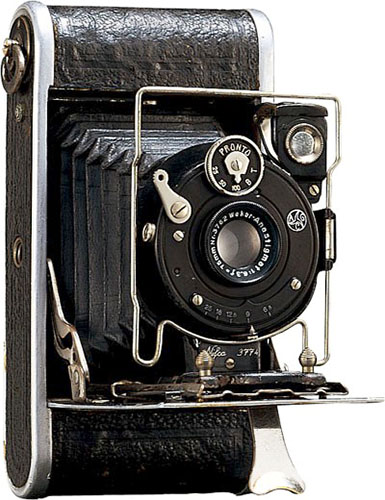

(Images from Minolta 70 year anniversary brochure)
Other folding Nifca models followed, then Sirius and Arcadia models. The company became Molta Gōshi-gaisha in 1931 with “Molta” derived from the German “Mechanismus Optik und Linsen von Tashima” with the English translation delivering the same acronym, “Mechanism, Optics and Lenses by Tashima”. Following disagreement about the handling of an industrial dispute by Willie Heilemann, both Germans had left by 1932 to form their own company, Neumann & Heilemann, which was later responsible for Japan's first TLR, the Prince Flex.
The “Minolta” name was first registered in 1933 and used for a camera based on the German Plaubel Makina. This used 6.5 x 9 cm plates or sheet film:
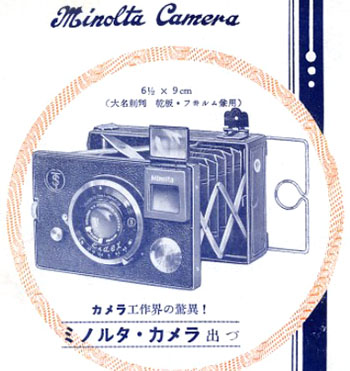
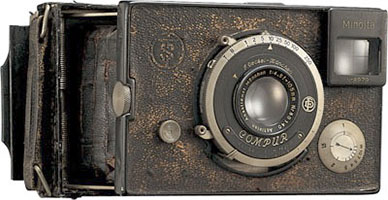
(Left, detail from larger brochure scanned by Andrea Aprà on Camera-wiki.org, right image from Minolta 70 year anniversary brochure)
It was updated with a coupled rangefinder in 1935 to become the Auto Minolta and in 1937, with flash synchronisation added, it became the Auto Press Minolta:
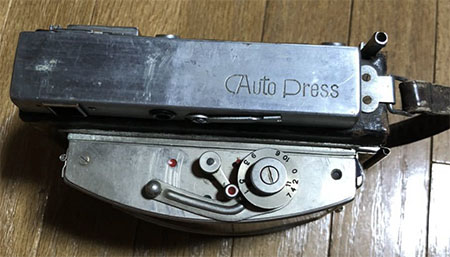
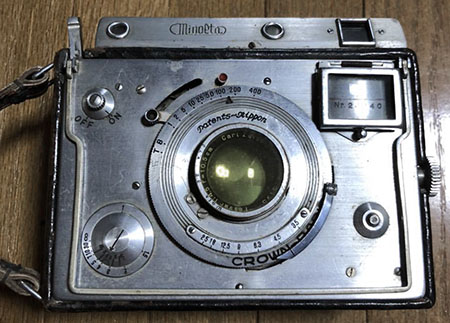 (Detail from larger web images)
(Detail from larger web images)
There is argument whether “Minolta” is an acronym of the German “Mechanismus, Instrumente, Optik und Linsen von Tashima” as stated in Sugiyama's book, or more likely, according to Camera-wiki.org, derived from the Japanese “minoru ta” meaning “ripening rice fields” and pronounced the same as “Minolta”. Both make sense for their own reasons, either is possible.
The Minolta Vest and the 4.5 x 6 cm Semi Minolta were released in 1934. Cameras such as the Vest, Minolta Six and Baby Minolta featured innovative Bakelite construction. Minolta Six released in 1936:
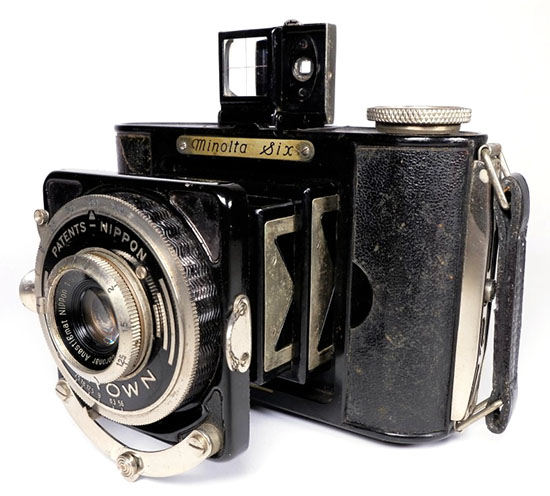 (Image courtesy of Chris Whelan)
(Image courtesy of Chris Whelan)
The Semi Minolta was the first of a series of folding 4.5 x 6 cm models made from 1934 to 1955. These used 120 film and half the frame of 9 x 6 cm models by rotating the camera so it was upright for landscape framing. Early model II example below, starting with later model II production, later cameras were fully die-cast:
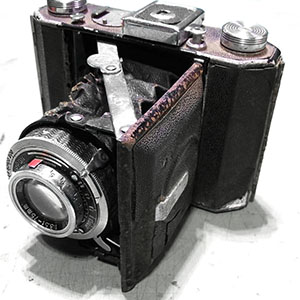
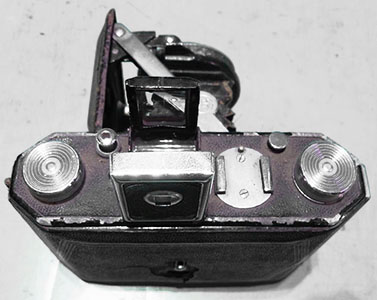
(Detail from larger web images)
The Semi was inspired by the 4.5 x 6 cm Zeiss Ikonta but the Auto Semi Minolta introduced in 1937 was a substantially more upmarket model only sharing a few parts with the Semi and was more influenced by the Welta Weltur. It featured a coupled rangefinder with combined viewfinder, i.e. with only one viewing eyepiece, and added auto-stop winding. The combined rangefinder/viewfinder was a precursor to the post-War Minolta 35 arrangement:
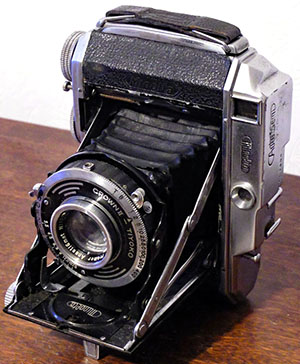
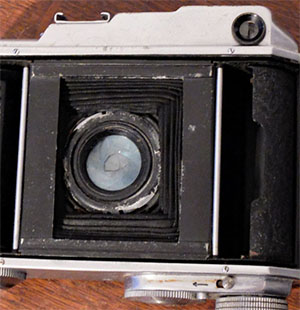 (Detail from larger web images)
(Detail from larger web images)
Also in 1937, the company was renamed “Chiyoda Kōgaku Seikō K.K.” which is usually translated as Chiyoda Optics and Precision Industry Co., Ltd. (the company's user instructions in English for the 1947 Minolta 35 translate it to “Chiyoda Optical and Fine-Mechanical Co., Ltd.” illustrating the difficulty of exact translations from Japanese to English). The name “Chiyoda” was derived from Japanese characters implying that Tashima's company would last one thousand generations. Sometimes the company name was abbreviated to “Chiyoko” (most of the standard lenses on the Minolta 35 are called “Chiyoko Super Rokkor”, only changing on the Model IIB f/1.8 lens).
It was also the year that the company started making some of its own lenses and released the Minoltaflex TLR, Japan's second TLR and first commercially successful one, arriving a few months after former technicians Neumann & Heilemann's Prince Flex. Previously, after the initial use of German lenses, it had mostly used lenses from Asahi Kōgaku Kōgyō (Asahi Optical Co.), Japan's largest glass maker and latter day maker of Pentax cameras. It's possible that the first Chiyoda Kōgaku lens was the taking lens of the Minoltaflex (plain “Minolta” on the nameplate):
 361x600.jpg) (Image courtesy of Barry Toogood)
(Image courtesy of Barry Toogood)
Sugiyama claims that Kazuo Tashima thought of the lens name “Rokkor” whilst gazing out of his office window at Mt. Rokko. The name was first used on a lens for a portable aerial camera made for the military in 1940 and continued to be used exclusively for military lens production until Chiyoda Kōgaku released the first new post-War camera in Japan, the Minolta Semi III in 1946 fitted with a Rokkor f/3.5 75 mm lens. This was the first coated lens commercially available in Japan:
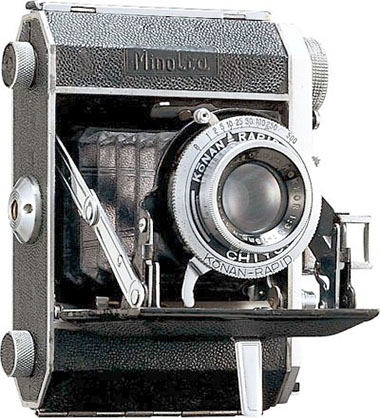 (Image from Minolta 70 year anniversary brochure)
(Image from Minolta 70 year anniversary brochure)
Before the War, Chiyoda Kōgaku had expanded quickly from its original Mukogawa factory and headquarters with new Amagasaki and Sakai plants and a machine tool factory in Komatsu. In 1942, the Imperial Japanese Navy requested the company to build a glass melting facility. A new plant was built in Itami but only became operational in 1944. Chiyoda Kōgaku also took over the former Neumann & Heilemann factory in Nishinomiya from new owner Fujimoto in 1943. Around this time, production of cameras for civilian use was suspended for the duration of the War during which the Mukogawa, Amagasaki and Komatsu factories were destroyed. The Sakai, Itami and Nishinomiya factories survived along with a facility at Honsha allowing Chiyoda Kōgaku to restart relatively quickly afterwards.
The Minolta 35 was the first sort of Leica copy released after World War II and as far as I can tell, it was the first by an established camera maker rather than by a start-up (I can only count 3 such releases, the Minolta 35, the Yashica YE & YF Nicca pair and the Russian Zorki). Until then, Chiyoda Kōgaku had been a maker of medium format cameras starting with 127 film and then plate, sheet and 120 film cameras but after the War, 120 film was in short supply because it was needed for x-ray cameras and camera makers were encouraged to make 35 mm models. Chiyoda Kōgaku had started by copying German models, but not slavishly, usually adding its own ideas to the mix. So when the Minolta 35 was released in 1947, it was perhaps not surprising that even though it worked like a Leica, it didn't look a lot like people expected a Leica camera to look like. Over the next almost twelve years, it evolved through 8 models and a number of lesser variations. Minolta 35 Model A:
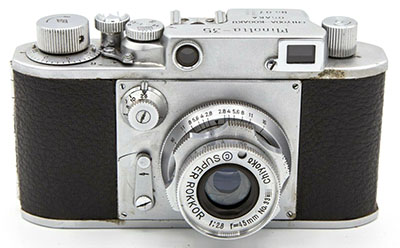 (Detail from larger web image)
(Detail from larger web image)
This was followed in 1949 by the first of the 35 mm leaf shutter fixed lens models, the Bakelite Minolta Memo (the film advance was by lever in the centre of the bottom plate) and in the mid-1950s, the A series rangefinder models. Memo on left, Minolta A-2 on right (upmarket version of the Minolta A):


(Images from Minolta 70 year anniversary brochure)
1950 saw the release of the Konan-16 Automat subminiature camera by Chiyoda Kōgaku (Minolta had bought out Konan's patents following that company's commercial failure with the original Mica Automat). The first Minolta-16 named model was released in 1955. The TLR range saw further development during the post-War Japanese TLR boom culminating in the 1955 Autocord models which survived to 1966:
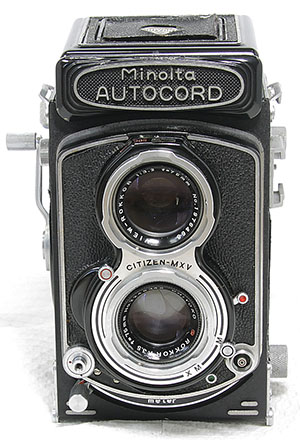 (From larger web image)
(From larger web image)
Founder Kazuo Tashima was an industry leader and in 1954, he sent the first Japanese mission to the United States to promote camera exports. He was also a President of the Japan Camera Industry Association established in April 1954.
Post-War camera production had largely consolidated into the factories remaining at War's end. A Minoltaflex user manual lists the following Chiyoda Kōgaku offices, factories and facilities circa 1953, quoted verbatim:
“Osaka Head Office:
3-chome, Kitakyuhoji-machi,
Higashi-ku, OSAKATokyo Branch Office:
3-chome, Ginza, Chuo-ku,
TOKYOHead Office Factory:
Minoltaflex, Minolta-Semi and Konan-16 are made in this factory.Itami Factory:
Optical glass is produced here.Sakai Factory:
Polishing and finishing of the lenses that are to fitted to various Minolta Cameras are produced here and distributed to other factories from this place. Besides lenses and prisms ordered from various overseas customers are being made in this factory and also Minolta 35 Camera are made in this place.Toyokawa Factory:
Minoltacord are produced in this factory.Nishinomiya Research:
Various optical research is made in this place.”
The Itami and Sakai factories and Nishinomiya Research facilities were all located close to Osaka. Below is the cover of a 1957 brochure about the company, its history, its then sites (including a location map), production capabilities and a page showing its current models. It is downloadable from the brochures page of this French Minolta site, minolta.suaudeau.eu:
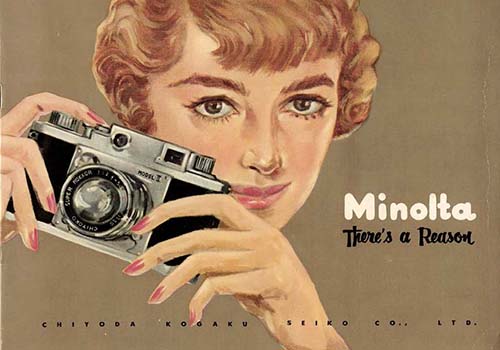
In 1958, Chiyoda Kōgaku released its first 35 mm SLR camera, the SR-2, which started a long line of SR models continuing even after release of its well received and very successful SRT101 model in 1966. Below left is the bigger selling budget version SR-1, initially the same as the SR-2 except 1/1000 top speed omitted and f/2 lens replaces f/1.8, below right, SRT101, the first of its own long series:
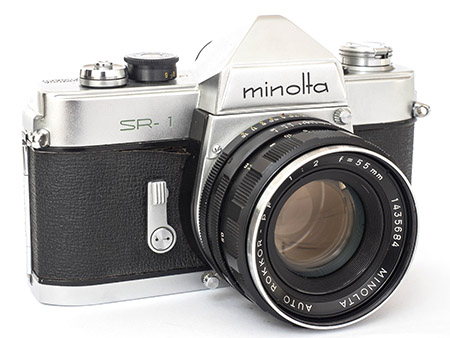
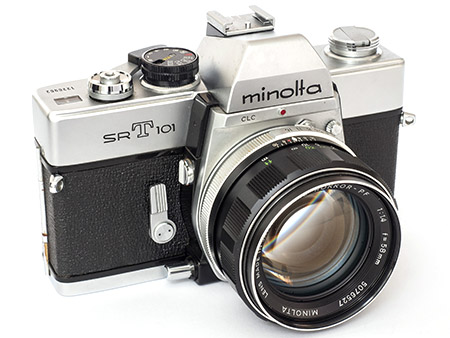
By this time, as a camera maker, it was principally a 35 mm film company, with notable exceptions such as the 1976 Minolta 110 Zoom SLR using 110 cartridge film and the obligatory 126, disc and APS models.
Diversification started in the late 1950s. The company built its first planetarium in 1958 and others were to follow. In 1960 it launched the product its office automation future would eventually depend on, its first photocopier.
Chiyoda Kōgaku changed its name to Minolta Co., Ltd. in 1962.
In an odd twist, on the other side of the World, Leitz was struggling in the new age of SLRs, even though it had developed its own (Leicaflex series), and in 1972 entered into an agreement with Minolta to jointly develop and share products. The first release was the M mount Leica CL compact rangefinder camera introduced in 1973. In the Japanese market it was named Leitz Minolta CL - who would have thought that possible?


(Detail from larger web images)
Based on Minolta SLR bodies and jointly developed technologies, the Leica R3 (Minolta XE based) and R4 to R7 range (Minolta XD based) followed, finally ending in 1997. Even some Minolta lenses were rebadged. Minolta XE (XE-1 in Europe, XE-7 in USA) on left, Leica R3 on right - different but almost the same:
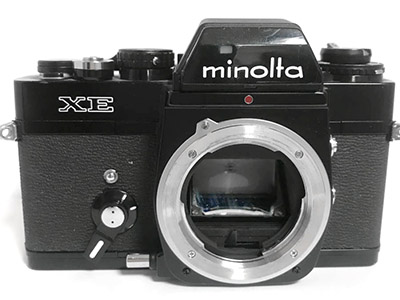

(Detail from larger web images)
But there was more. Leitz was a leading developer of autofocus but then sold its patents to Minolta, apparently because it didn't think Leica users would have a need for automatic focusing. Whilst starting in 1981, there were earlier autofocus SLRs/lenses released by Pentax, Canon and Nikon (not including Polaroid's 1978 sonar based ystem), the very successful 1985 Minolta 7000 (α-7000 in Japan, as below, and Maxxum 7000 in USA) was the first SLR with both drive and sensors in the body as well as combining a built in motor drive:
 (Detail from larger web image)
(Detail from larger web image)
That became the default system until Canon disrupted things again with its EOS electronically controlled lens system and drive in the lens. However, maybe Leitz had the last laugh. In 1987, Honeywell Inc. filed a lawsuit against Minolta (and most major camera makers). Honeywell had been awarded a number of patents for an autofocus camera it was developing but ended up abandoning it in the mid-1970s. Minolta lost the case and the final settlement was US$127.5 million, which coupled with other difficulties, was a severe blow.
As the digital age dawned, life in both the photographic and photocopier and allied products industries became more expensive, more competitive and more difficult to survive in. In 2003, Konica Corporation and Minolta Co., Ltd. merged to form Konica Minolta Holdings Inc. Konica was Japan's oldest photographic company with its origins dating from 1873. Konica Minolta stopped making cameras in 2006 and exited the photographic and camera business in 2007. In 2005, it had already started cooperation with Sony on development of DSLRs and Sony inherited that side of the camera business. For the time being, Minolta's SLR DNA lives on in the Sony's Alpha lens mount.
Chiyoda's Distributors
I have mainly included this section to help understand the relevance of other company's names that might appear on early Minolta ads, brochures and other documents.
Before the War and even afterwards for a while, it seemed to be common practice for Japanese camera makers to use the services of specialist companies to handle the distribution and sales side of the business. Canon initially used Omiya Shashin Yohin (Omiya Photo Supply) and Nicca employed Hinomaruya from 1950. According to Camera-wiki.org, the then Molta (Minolta) first used distributor Asanuma Shōkai (Asanuma & Co, Ltd.) from about 1933. Asanuma had a history dating back to at least 1871 and had earlier itself made some large format cameras. In 1937, the relationship between the now Chiyoda and Asanuma became closer and Asanuma stopped distributing other brands to concentrate on Minolta cameras.
It had exclusive rights to Chiyoda's cameras until after the War when business dynamics irrevocably changed and Japanese camera makers had to turn from producing for the well-to-do to competing for survival in export and local mass markets. Nevertheless, Asanuma remained an authorised dealer until at least 1952, i.e., through the early years of the Minolta 35. However, there was also now another player.
The earliest known user instructions for the Minolta 35 are in English for the earliest version of the Model A (1947, fits with early production being for export only), apparently issued by Chiyoda Kōgaku itself but with the blue ink stamp on it of the following company (see Flash Synchronisation):
Miura Trading Co., Ltd.
EXPORT AGENTS
Oaricho Bldg, Ginza, Tokyo
An English language Model E brochure (1952) has a later Miura stamp on the cover and an English language Model F user manual has it on an inside page (same details except no second phone number):
Distributed by:
MIURA TRADING CO., LTD.
Rooms 319, 321 Marunouchi Bldg.
Tel: (20) 3481-5 (24) 7670
An English language user manual for a Minoltacord claimed to be from 1953 also features a similar Miura stamp but with different room number:
Distributed by:
MIURA TRADING CO., LTD.
Room 226 Marunouchi Bldg.
Tel: (20) 3481-5
Little is known about Miura Trading Company and even less, its connection to Chiyoda Kōgaku. Camera-wiki notes that the short-lived sub-miniature pseudo TLR Gem Flex made by Shōwa Kōgaku Seiki (maker of the Leotax Leica copies) was advertised in Japanese media as distributed by Miura Shōji of Ginza. In fact, there is a glossy English language folded instruction sheet for this cheap and not very successful camera with only the Miura Trading Co. name printed on front and back covers, no maker name.
The little that I know is related to Miura's connection to Yashica, or rather Yashima as it then was. All Yashima's/Yashica's Japanese warranty documents in the 1950s were issued by the company itself and US warranties by it's New York subsidiary from the end of 1957 onward. However, there are a small number of English language warranty documents issued by Miura Trading Company from as early as 1955 through to at least 1961. It may have been involved with Yashima's early exports but there is no indication of that and certainly, it was not used after 1957 to the US. However there are indications that Miura Trading Company was, or was mainly, associated with Yashica cameras sold on US military bases through PX, NX stores etc.
So in connection with Chiyoda Kōgaku, the Miura Trading Company's possible roles ranged from dealer, distributor, export agent through to US base exchange store agent, but was more likely one of the latter two.
The 35 mm Format Wars
There has been much debate and commentary about the Minolta 35 image frame size, some misguided and some, well, still debatable. It affects all models from beginning to end and to understand the camera and its character, we need to understand the issue. There are three separate but related aspects to this.
Japanese vs Leica Format
Sometimes called the Japanese format (or Nihon, or Nippon), the 35 mm film 24 x 32 mm frame size (4 x 3 format) mentioned on the Leica Copies page was also initially adopted by Nippon Kōgaku (Nikon), Takachiho Optical Industries (Olympus) and some others but Chiyoda Kōgaku's Minolta 35 was the first in Japan in 1947 (that frame size had been used as long ago as circa 1928 on the US made Q.R.S Kamra and perhaps even on the 1926 Ellison Kamra which may be related). There were some claimed practical Japanese market reasons for doing so, such as the economy of an extra 4 frames per roll (argument negated when Chiyoda Kōgaku went from 7 to 8 sprocket holes per frame and hence 36 of the smaller frames) and the Japanese Ministry of Education slide projectors using that size (chicken and the egg, what came first, camera or projector?). However, I believe the main reason why that 35 mm frame format existed at all was that the companies involved couldn't get their minds around the Leica 3 x 2 format when 4 x 3 was considered the “ideal” format and closer to most available larger printing papers, such as 8 x 10.
Whilst Nippon Kōgaku actually said that, companies such as Chiyoda Kōgaku and Takachiho Optical had been making medium format cameras with image ratios ranging from square to 4 x 3. Even though 6 x 9 cm (also 3 x 2 format) folding cameras using 120 film existed, the format didn't seem to be popular in Japan. Medium Format was often used for portraiture where the 4 x 3 ratio seemed more natural than 3 x 2. On the other hand, the more expansive Leica format and the camera itself was most suited for landscape views of, well landscapes, sport, reportage, street photography and generally seeing as the eye does. These days with modern technology, we like to see things even wider. In my view, these companies didn't fully appreciate what the Leica meant, it wasn't just a camera, it was a change in photographic thinking.
Regardless of philosophical preferences, the realities of selling to the Americans and their automatic slide cutting machines meant that these experiments in individualism didn't survive long. Except for Chiyoda Kōgaku. The company was dragged kicking and screaming to first 24 x 33 mm (Model C when the frame spacing was changed to 8 sprocket holes and hence 36 frames per roll making the exposed film friendly for automatic slide cutting machines) and then 24 x 34 mm format (Model D, version 2), but even a prime opportunity like a major update in 1955 didn't make the company flinch and many claim that 24 x 36 mm, 3 x 2, didn't arrive until the last year of production in 1958 (Model IIB), if at all. But I'm getting ahead of myself, the IIB is the third aspect of the format wars, first there is the second aspect to deal with. I'm also probably being unfair, changing to 24 x 36 mm possibly wasn't that simple, it was unlikely to have just been a matter of making the image frame mask, the “hole” in the shutter cover, wider since the body structure itself had originally been designed with a smaller frame size in mind and 34 mm (or 34.5 mm as we are about to see) may have been the limit of what could be achieved without a major retooling.
The 0.5 mm Debate
There are also claims that the Model E featured a slight frame increase to 34.5 mm wide. This 0.5 mm is passionately claimed by some to be real and ignored by others. Did it happen? The weirdest thing is that this is not just a debate amongst collectors, Chiyoda Kōgaku couldn't seem to make up its own mind about what size the image frame was.
Basically, the story is that the Model D (type a) started off with a frame size of 24 x 33 mm and changed to 24 x 34 mm (type b), then when the Model E arrived, the frame size increased by a further 0.5 mm to 34.5 mm. Was it a conscious increase? It's possible but it's also possible that the Model D type b started at slightly wider than the spec suggested and some advertising bright spark decided that it was a marketing opportunity with the Model E. The consensus seems to be that the Model E was released late in 1951, one site says November. Below is the top part of a page that lists Japanese 35 mm cameras (there are a number of pages covering all formats). It is claimed to be from 1951 and is therefore more likely to list the Model D than Model E, particularly as the now official “Model E” name is not mentioned yet different Canon and Nikon models are. Whether referring to the Model D or E, it is probably one of the earliest independent references to the 24 x 34.5 mm size.:
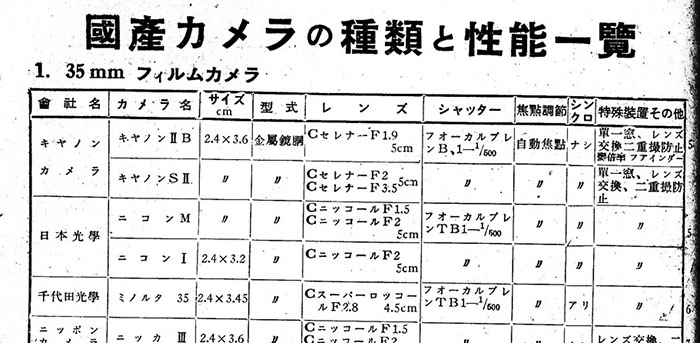
The first column is the maker, the second is the camera model and the third is the image size. Top down, the camera models are Canon II B, Canon S II, Nikon M, Nikon I and Minolta 35 with its “2.4 x 3.45” cm size.
Larry Huffman on the Minolta page of his very good Canon Rangefinder Cameras site (no longer accessible) said that he had used precision calipers to measure the frame size and that starting with the Model E, the 0.5 mm increase applied to the following Models F and II. That's not my finding with the Model II. Using a simple steel ruler, my earlier Model II type a2 with pressed metal shutter cover/image frame still seems very close to 34 mm, a fraction under if anything:
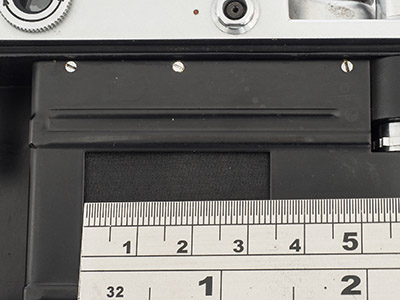
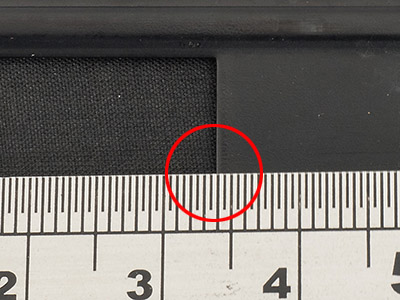
Dennis Oyama of the This Old Camera website has used callipers to measure the frame sizes of two Model II type a1 examples and one type a2 example like mine and found them all to be 23.4 x 33.8 mm, so a bit short in both directions and putting an actual figure on what my ruler measurement hinted at. (This Old Camera has some excellent information on Minolta 35 repairs and workings as well as for many other cameras.)
Dennis also measured a Model II type b1 with the revised body but pressed metal shutter cover still and found that to be 23.5 x 33.9 mm, so a fraction larger but still short of 34 mm let alone 34.5mm. Using my ruler, I had previously measured my later Model II type b2, the first with cast alloy shutter cover/image frame, which looks like it is close to halfway between 34 and 34.5 mm but no reason to round up to a 1/2 mm increase, besides, this may just be an anomaly:
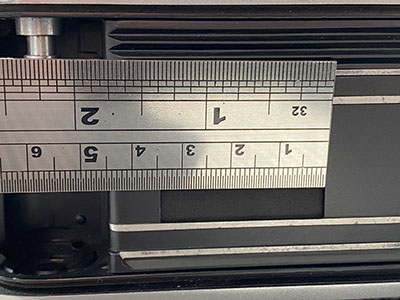
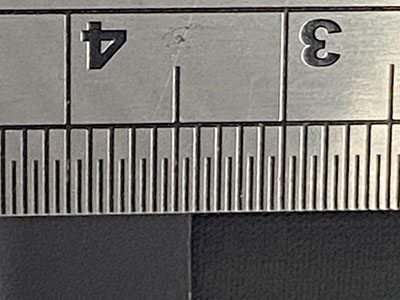
Spoiler alert, any excitement should be tempered by my measurement of the IIB, see Minolta 35 Model IIB Frame Size further below, which has the same cover type but seems to be exactly 34 mm. I accept that my methodology is not that accurate but given that my first measurement was in the ball park compared to Dennis' callipers, it seems that the new cast alloy shutter cover is slightly wider than the earlier pressed metal version but not significantly and maybe not consistently (or maybe that is just me). Perhaps some earlier Models than the II series were measured at, or close to, 34.5 mm but Chiyoda Kōgaku tightened up on its manufacturing tolerances?
As evidence of a conscious marketing decision, Larry Huffman provided an image of 2 pages of “Minolta literature packed with the Minolta E” with the cover page clearly about the Model E and the second page, perhaps last page of more pages, blank except for the statement:
“KNOW YOUR CAMERA
CAPACITY: Picture size 24 x 34.5 mm
36 exposures on Standard 35 mm film
”
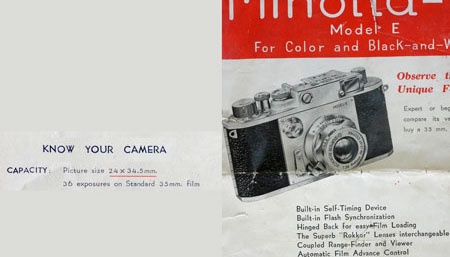 (Relevant part of the brochure from Canon Rangefinder Cameras)
(Relevant part of the brochure from Canon Rangefinder Cameras)
In the Yin and Yang of this debate, a multi-page brochure with the same Minolta E cover page on the Pacific Rim Camera site makes a counter-claim. Below is the cover page and the top part of page 4 which clearly states that the size is 24 mm x 34 mm:
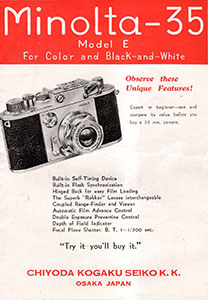
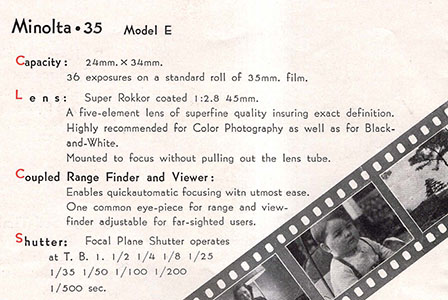
(The full PDF brochure is available for download on the Minolta page of the Pacific Rim Camera site. The site also has a Rokkor lens brochure for the Minolta 35 and and other Leica mount cameras and an English language Model E user manual and a Japanese language one for the Model II. There are many other brochures and documents related to other Minolta camera models, including TLRs but mainly SLRs, and other products including exposure meters.)
Then, on the other hand, the English language Model E user manual, also available for download from the Minolta page of the Pacific Rim Camera website, again supports the 24 x 34.5 mm size. Cover and page 3:
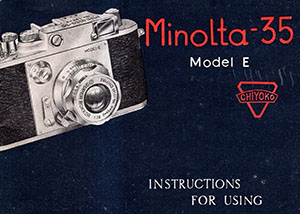
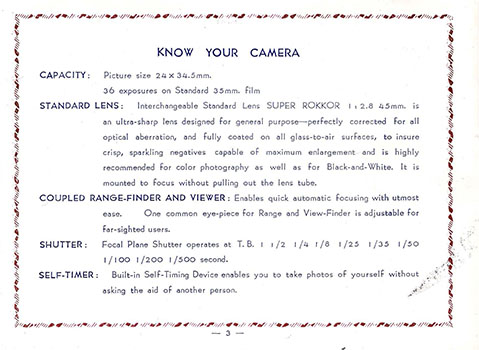
But the almost identical English language Model F user manual from about 12 months later, available for download from the Minolta Collectors Facebook group, reverses that claim and in one of its few key differences says that the picture size is 24 x 34 mm. Cover and page 3 of the F manual:
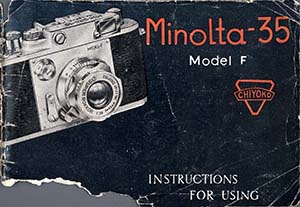
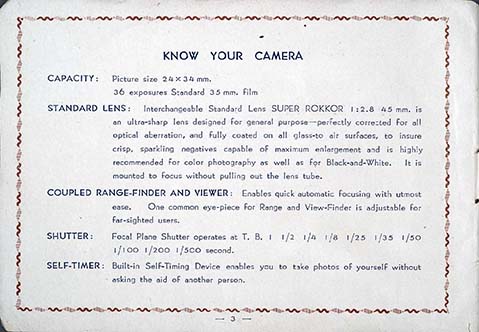
Below is my Japanese Minolta camera range brochure which includes the later Minolta 35 Model II and all its lenses:
You don't need to use a translate app to understand that the specs for the frame size are 24 x 34 mm. Below is part of a leaflet for the Model II, which again rounds down (the same page with a slightly different border features in a foldout brochure for all Chiyoda Kōgaku's cameras):
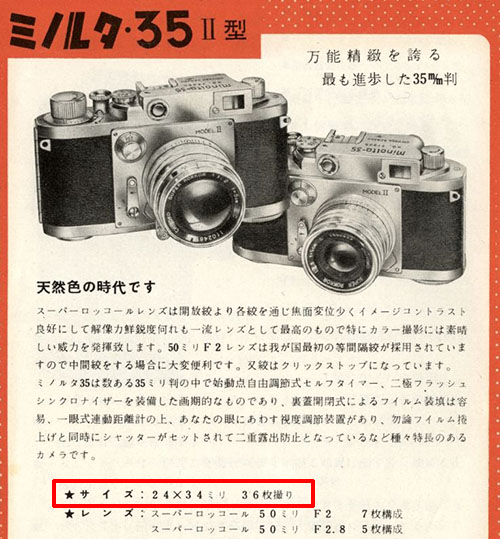 (Part of leaflet on Mike Eckman's site)
(Part of leaflet on Mike Eckman's site)
Neither the English nor Japanese versions of the user manual mention frame size, so based on the Model F user manual and Model II brochure and leaflet, one has to assume that in a rational moment Chiyoda Kōgaku thought it was pedantic claiming the extra 0.5 mm and that it detracted from its marketing, maybe only emphasising the fact that it was a bit small. It's also possible that the 0.5 mm oversize frame was only present in the Model E (and perhaps Model D type b).
In arguing against an increase of 0.5 mm being noteworthy or relevant, Swiss collector Renaud Laemmli tells us on Sylvain Halgand's Collection Appareils site that the frame size of the first Minolta 35 Model A was actually 24.5 x32.5 mm rather than the specified 24 x 32 mm.
In any case, Chiyoda Kōgaku stepped back from its 0.5 mm claim and from here on in, I won't mention it again, well, not much.
Minolta 35 Model IIB Frame Size
Whilst most references and even Koichi Sugiyama's book, “Collector’s Guide to Japanese Cameras”, claim that the Model IIB has an image size of 24 x 36 mm, Swiss collector Renaud Laemmli, again writing on Sylvain Halgand's Collection Appareils site, tells us that is a mistake and that there was no increase in frame size for the last model (note, the information is not there on the English version of the page, select French version and use the translate function of your browser). Although he may sound like a lone voice in the wilderness, he is associated with a respected site and seems to have an unbelievable collection of Minolta cameras as well as examples of most Minolta 35 models and versions. His classification system is based on work done by Minolta expert Andrea Aprà.
As there were no major changes to the late II body in moving to the IIB, and the fact that Chiyoda Kōgaku had held out for this long, it made sense to me but there is nothing like a measurement to confirm the fact. I have now acquired a Model IIB (serial number 105911) and can confirm that it is similar to my Model II type b2 above, but whereas my Model II type b2 looked like it was slightly more than 34 mm, this IIB looks like it is almost exactly that. Clearly, the 24 x 36 mm myth is busted, the Minolta 35 Model IIB image size remained 24 x 34 mm:
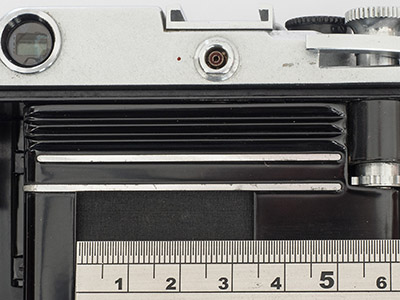
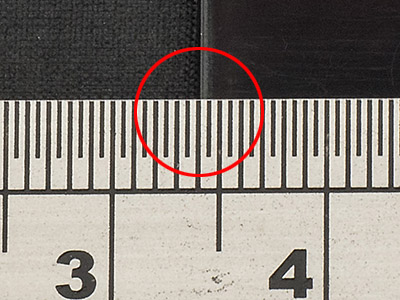
The reality is that 2mm (or 1.5 mm if you are a 34.5 mm believer) is not a major difference photographically, but Leica copy definition wise, it's relevant. The fact that it is so widely believed that the IIB adopted the 24 x 36 mm format suggests that there must be a basis for it somewhere, whether in something like Chiyoda Kōgaku advertising, or perhaps an eminent source has made a mistake (Sugiyama certainly has and European researchers and authors are likely to have referred to his work).
The Minolta 35 Camera
The Minolta 35, designed by Hajimu Miyabe, was introduced by Chiyoda Kōgaku in May 1947. In the early 1950s, Hajimu Miyabe was said to be the chief designer at Mamiya (camera-wiki.org) so he was unlikely to have been involved in the later refinements. July 1948 Japanese Camera Times ad for the Minolta 35 and the Semi Minolta:
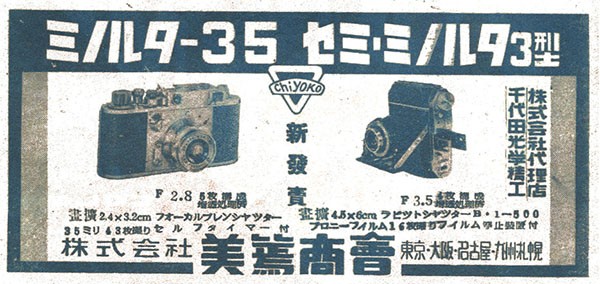
December 1948 Japanese Camera Times ad coincidently on the same page as competitor Canon:
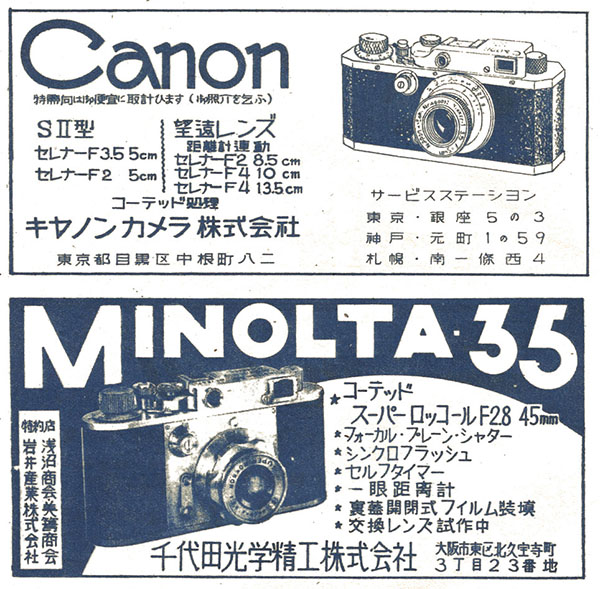
It was a big, heavy camera, at least in comparison to the Leica IIIc/f and its closer copies. In actual fact, unlike some, the width and thickness are very close to the Leica, it is the height that accounts for the size impression, and probably most of the weight difference. Nearly all the additional height is in the blank area between the rangefinder/viewfinder windows and the lens mount - that is where the shutter release gears and high speed gears are all positioned in one block which probably makes it easier and faster for production line assembly than the Leica's less modular but more compact shutter design.
 (Detail from larger web image)
(Detail from larger web image)
The Minolta 35 is noticeably heavier to hold but feels comfortable in the hand. Bigger hands may appreciate it. By itself, it is a nice looking camera but looks a little ungainly next to the Leica.
1955 Minolta 35 Model II type b2 with f/2.8 5 cm Super Rokkor on left, 1946-7 Leica IIIc with f/2 5 cm Summitar:

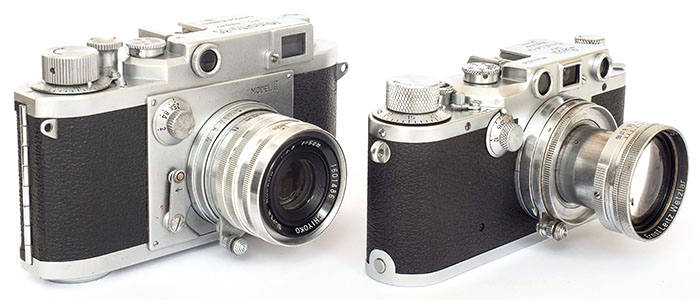
Apart from the convenience of the self-timer and allure of the combined rangefinder/viewfinder, arguably its greatest attraction was the hinged opening back with fixed take-up spool. Same model II again:
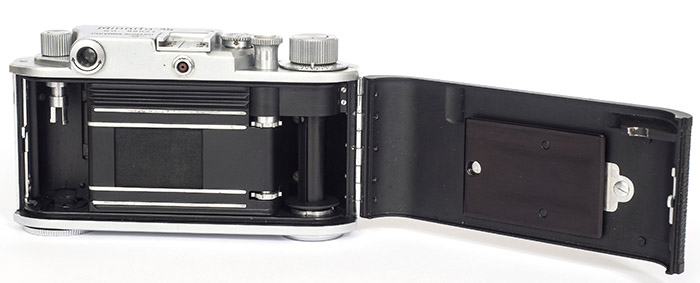
Whilst the self-timer was a bonus, it was located very close to the lens and causes problems with the focus levers of other make lenses. Note, some have claimed that the Minolta 35 featured a self-timer before it appeared on the Leica IIIf in 1954 - the first Leica with a self-timer was actually the Leica IIId of 1940, although no new Leica screw mount camera with a self-timer was available for the first 7 years of Minolta 35 production.
Below is a table comparing Model E/F dimensions from their user manuals (probably the same/similar to their predecessors), measured bare Model II/IIB bodies, the Leica inspiration and marketplace competitor Nicca:
| Dimension | Minolta 35 Model E & F |
Minolta 35 Model II type a2 |
Minolta 35 Model II type b2 |
Minolta 35 Model IIB |
Leica IIIc/f |
Nicca 3F |
|---|---|---|---|---|---|---|
Base Plate Length |
135mm |
135mm |
135mm |
135mm |
135mm |
139mm |
Camera Height |
75mm |
79mm |
79mm |
79mm |
69mm |
71mm |
Base Plate Width |
31mm |
31mm |
31mm |
31mm |
30mm |
31mm |
Body Weight |
584g |
575g |
595g |
425/430g |
448g |
(Note: All bodies are die-cast. The Model E and F use the early Minolta 35 body as does the Model II, type a2. The late body Model II in the photos and table is the type b2 which may be largely the same under its new covers but surprisingly, is 9 g lighter, perhaps largely due to the cast aluminium shutter cover instead of the pressed brass plate on the type b1 and earlier models. The type b2 also forms the basis of the following IIB. I measure all three II/IIB bodies at 79 mm high, a little less than 3 mm increase in height is due to the new locking mechanism and matching tripod mount on the base plate, the other millimetre or so could be a difference in measurement technique. The Model E & F user manuals each quote a total weight of 800 g. My last type 45 mm lens, minus its missing focus lever, weighs 186 g, which seems to be more than the earliest versions at 160 g, plus the type a2 body add up to a total of 770 g - did Chiyoda Kōgaku round up or perhaps the case and lens cap were included?)
The early Leica copy cameras like the Canon, Leotax and Nicca were focussed on building Leica substitutes. None of them made other format cameras first or even different types of 35 mm cameras until much later and so their starting point was always the Leica and the whole of the company's focus was on its next flagship interpretation. Chiyoda Kōgaku was different. It was the oldest and made different medium format cameras at various price points and feature sets. It had started by using German lenses and shutters and had based its models on German designs but there were no close copies. Pre-War, it was already making die-cast bodies, in fact a couple of years at least before Leica released its IIIc. The combined rangefinder/viewfinder seemed like a big deal in 1947 but it already featured on the 1937 Auto Semi Minolta.
To me it seems that Chiyoda Kōgaku was aiming for a different market than that inhabited by Leica and its aspirants. It's a solid, well constructed camera with ease of use at the forefront. Minolta could have gone all out after the professional market but didn't, its feature set and design details were balanced against a reasonable price. In 1947, its body and features were at least a challenge to Canon but Chiyoda Kōgaku never got into a technology race and despite almost constant refinements, it was still much the same camera over 11 years later. Price wise, it appears to have been competitive. In the mid-1950s, ads and brochures featuring it with the recently arrived f/2 lens put the Japanese price in the ¥48,000 to ¥49,000 range, similar to the comparable Nicca 3-F and Leotax F at the time and well below cameras from Canon and Nikon. In fact, the US Department of Commerce booklet, The Development of the Japanese Photographic Products Industry, 1954-1958, lists Japanese retail prices of a number of makers models and confirms the Minolta 35 Model II retail price as at 31 March 1957 as ¥49,000 for the f/2 lens version but only ¥39,800 for the f/2.8. The advertised price for the more refined 1958 Model IIB with new f/1.8 5 cm lens was only ¥42,800. The top speed never rose above 1/500 but the most telling aspect are the lenses (see below). This was a camera for advanced amateurs rather than a Leica substitute or tech tour de force.
About the Lens Choice
The Rokkors are quality glass but they never challenged the limits of what was possible. In 1947, when most standard LTM lenses were f/3.5 with a focal length of 50 mm, but conveniently collapsible, and the largest apertures were f/2, often also collapsible, a rigid compact lightweight aluminium f/2.8 with a focal length of 45 mm lens may have seemed like more than enough to be competitive but within a year or two, that would have been considered inadequate by enthusiast photographers and more professional users with f/2 becoming the standard and f/1.5 to f/1.1 there for the light challenged. It would be 1954 before Chiyoda Kōgaku even offered an f/2 lens. That was part of the trade-off for keeping the camera affordable.
Whilst 45 mm may seem sensible to modern us, to most consumers then, it probably seemed odd compared to the Leica established 50 mm “norm”. However, to confound both folk back then and also now, the angle of view for a 45 mm focal length on a 24 mm x 32 mm frame is not so far from 50 mm on a 24 mm x 36 mm.
Being also a lens maker, Chiyoda Kōgaku offered a basic range of Rokkor accessory lenses, although the wide angle 35 mm didn't arrive until probably 1956, and whilst quality wasn't an issue, the relatively slow maximum apertures of the range made them acceptable rather than desirable for most enthusiasts but perhaps OK for the intended market segment. The unusual 11 cm featured a particularly dark maximum aperture of f/5.6.
The Rangefinder/Viewfinder Compromise
The combined rangefinder/viewfinder was a highlight when the camera was released in 1947 and whilst it would have been nice to see some bigger improvements in size and addition of frame lines over time, it still remained a more convenient and less disjointed experience than the Leica IIIf and it's imitators. However, there was a significant compromise and that was rangefinder accuracy.
Rangefinder accuracy is determined by “effective base length” (EBL), the longer the better. EBL = base length x magnification. Leica III models have a 39 mm base and a magnification of 1.5 times giving an EBL of 58.5 mm. The Leica base length is considered short anyway but that is consequence of the camera design and placement of controls and the 1.5 magnification helps mitigate some of the shortcomings. Because of the needs of the viewfinder, combined rangefinder/viewfinders usually have a magnification of less than 1 times. Due to being restricted by the Leica-like top plate design, all the Minolta 35 models have a base length of 40 mm, the following are the reported magnifications and resulting EBLs over the life of the camera:
- Models A & B: 0.33x, EBL = 13.2 mm
- Models C, D, E, F, II: 0.7x, EBL = 28 mm
- Model IIB: 0.8x, EBL = 32 mm
So rangefinder accuracy can only be described as problematic, particularly with the two early A and B models, and well short of the Leica and its close copies. The longer the lens focal length, the more difficult accurate focus is and greater depth of field may be another reason for keeping apertures relatively small.
Viewfinder Window
I don't know if or how magnification affected the window size but there seems to be little, or no, correlation between the reported magnification changes above and window size. On the other hand, optical changes with the arrival of dioptre adjustment with the Model E seemed to have a bigger impact. From left to right below:
- The polished chrome frame didn't appear to change shape or size from the Model A to the Model D, although it could have as the image format changed slightly with both the Model C and D.
- The Model E and F, now with diopter adjustment and probably new optics, seem to have a bigger window with narrower chrome frame and new shape around the adjustment screw.
- The early Model II type a1 window appears to remain the same size, measured at 13.5 mm wide for this model, but with a new sharper edged satin chrome frame with a modified shape around the adjustment screw.
- Roughly half the Model II type a2 windows are the same 13.5 mm type but the rest are the smaller 11.5 mm type with a wider frame like most of the following type b1 and b2 windows. My database confirms that the larger windows belong to cameras supplied with the 45 mm lens and the smaller ones belong to the cameras supplied with the new f/2 5cm lens which has a narrower angle of view. The frame acts like a mask.
- With the f/2.8 5 cm lens now replacing the 45 mm version, most Model II types b1 and b2 with the new top and bottom plate have the 2 mm smaller window measured at 11.5 mm wide but there are a few early type b1 examples with the larger window and these coincide with the small number of cameras sold with the last of the 45 mm lenses.
- Model IIB again has a bigger 14 mm wide window with a narrower frame to compensate and the proportions (9 x 14 mm) are more like the 3 x 2 format of 24 x 36 mm even though the actual image size remained 24 x 34 mm, see further above. The diopter adjustment is gone, there is increased magnification and therefore the optics are probably new. Note the rectangular eyepiece frame whereas previously, it was circular.


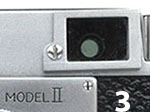
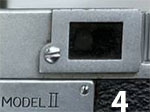

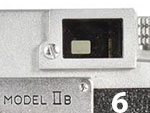
Flash Synchronisation
Accurate flash synchronisation, or flash sync, information for the Minolta 35 is even more problematic than I found it for the Leotax and Nicca. Basically, a flash bulb is connected to the shutter mechanism by an open electrical circuit, when the shutter fires, it completes the electrical circuit and fires the bulb. With the Minolta, figuring out how the electrical connection between the flashgun and the camera works and when it was introduced are the hardest parts. It has to be remembered that whilst flash synchronisation was still not that common, Chiyoda Kōgaku had first used it on the Auto Press Minolta of 1937.
Some websites don't mention flash sync prior to the Model E. Some acknowledge that initially, the Minolta 35 used a primitive form of hot shoe without any real explanation. One site says the same but claims that it wasn't introduced until the 1949 Model D. Part of the issue is that there is very little documentation about it plus from the Model A to the Model D, the accessory shoe just looks an ordinary shoe with a big central pressure ball.
On Sylvain Halgand's Collection Appareils site, collector Renaud Laemmli explains how it works and that it was there from the beginning (don't use the English version page, the explanation is only on the French page - use a translate app) confirmed by the Model A user manual (the slow speed shutter dial lock is featured, it was omitted from type c of the Model A onward). The manual referred to by Renaud Laemmli is actually in the form of an instruction sheet issued by Chiyoda Kōgaku in English. The translation is a bit confusing but helpfully, there is a link below the photographs on the Collection Appareils page to a PDF of the instruction sheet, a small version which is below left (the actual sheet is on Italian enthusiast Massimo Scotti's website, massimoscottinelweb.com, which has a vast array of Minolta downloads, mainly from later than the 1950s). I have extracted the relevant sections and pasted them into the montage on the right:
(Click on right image for link to larger image)
The relevant descriptions from the sheet are:
“F Slow Lock Button”
“J Terminal for Flash Synchronizer” (pointing to the pressure ball) and
“5. Flash Synchronizer
Flash Synchronizer will be used inserting the socket of Flash lamp in to terminal (J) on the camera.”
Two sources are better than one and just to confirm that early and later information hasn't been mixed up and that the sheet is probably the only form of user manual, below is the top part of an instruction sheet in Japanese for a slightly later model - the slow speed shutter dial lock is no longer evident or described and the 4526 or 4826 serial number identifies it as a Model C (small full version is at Model C together with download link):
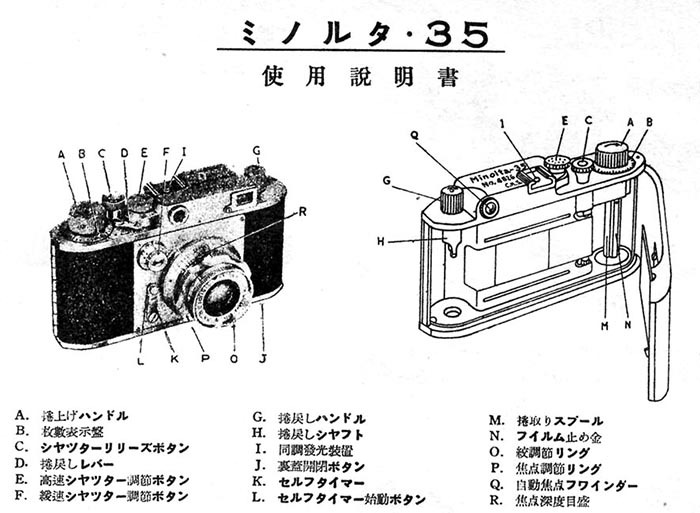
The sync reference this time is “I” which translates as “flash synchroniser”.
Chiyoda Kōgaku offered a flashgun, the Minolta Flash-Unit Type U which was also suitable for the synchronised Semi Minolta IIIB (introduced a year or two after the 35). Left image below is on the box for the flash unit, the tiny image on the right (the only one I have been able to find) is the connector in the centre of the Type U flashgun foot:
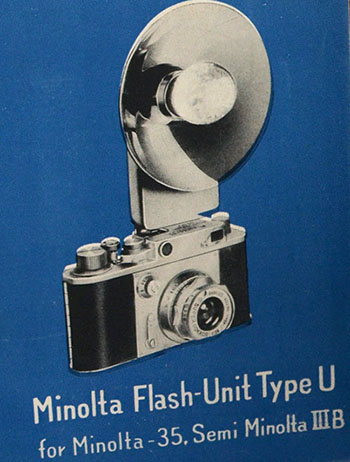

(Left detail is from a larger image on Camera-wiki.org, right detail is from larger web image)
I'm not sure how the the Type U sync worked with the Semi Minolta IIIB. Like its predecessor, the IIIB had a central rectangular pressure spring rather than the 35 ball but it also had a single sync post on the shutter (sync posts are normally found in pairs).
It was not an original design, a similar hot shoe sync arrangement had debuted on the 1938 US made Univex Mercury. Whilst no doubt a bit crude, the early hot shoes were on the right track and precursors to the almost universal adoption of the modern type. A claim has been made on the photoclubalpha.com website that the Minolta 35 will fire a modern hot shoe flash. The biggest issue was that back then, it was proprietary. Examples of the flashgun are very rare so it was probably not very popular.
The Minolta 35 Model E was released in 1951. That dropped both the hot shoe concept and the pressure ball and instead provided a socket on the back just below the shoe, like a Leica. The type of socket is unknown and is not named in the user manually which helpfully suggests a couple of Minolta flashguns which are suitable.
The sync socket is quite different on the Model F but still not the PC type. The outer collar is different to the later PC types and the centre pin/shaft is solid whereas the PC type has a hollow shaft with inner tube separated from outer tube by an insulator. The F socket pin, or shaft, seems thicker than ASA types usually but could be one. Bizarrely, the user manual, almost word for word identical to the Model E manual on most pages, is also identical for flash use, i.e. the sync type is not specified and the same two flash units are recommended.
The various connectors on the cameras are shown below. Left to right, Model A to D hot shoe (C shown), Model E unknown socket, Model F unknown socket and Model II PC socket



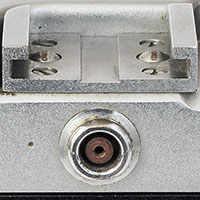
(Left three, detail from larger web images).
The first mention of X sync for electronic flash is made in the Model II type a2 user manual coinciding with the first appearance of the red X on the slow speed shutter dial. The manual also advises the use of FP bulbs without any speed restriction so clearly the sync was now auto switching like on later Leotax and Nicca models. Presumably, the earlier sync for flashbulbs was also FP - the Model E manual doesn't mention sync or bulb type, merely to connect the “electric cord” and there will be “perfect synchronization”.
See also Flashguns below:
Made in Occupied Japan, Other Markings & Labels
A more detailed explanation can be found on the Canon page. Basically, the Supreme Commander for the Allied Powers (SCAP) in Japan issued an instruction on 20 February 1947 requiring all export products to be marked “Made in Occupied Japan” (MIOJ). Although repealed at the end of 1949, some companies including Chiyoda Kōgaku, Showa Kogaku (Leotax) and Nicca continued the practice through to 1951 and the signing of the peace treaty ending the occupation whilst others, such as Canon, ended it immediately. In the case of the Minolta 35, it carried through to the end of the Model E. There are a few earlier cameras without the marking in my database, presumably because they weren't for export, but all later ones while the marking was still in use, including examples from Japan, have it. With the arrival of the Model F, the inscription changed to “Made in Japan” (MIJ):


(Detail from larger web images)
The Model II types a1 and a2 moved the name to the new tripod pedestal and the types b1, b2 and Model IIB feature the shortened inscription of simply “Japan”, although there still are the odd MIJ examples near the beginning of the type b1:

 (Left, detail from larger web image)
(Left, detail from larger web image)
The other markings found relate to Japanese taxation rules and the selling of duty free cameras through typically the US Military Exchanges (e.g. Army PX, Navy NEX). The first is the Central Purchasing Office mark, <CPO>, introduced by General Douglas MacArthur's General HQ, Far East Command (GHQ, FEC)in 1948 or 1949 according to Camera-wiki-org but I think 1947, and its slightly later Japanese katakana equivalent, <シーピーオー>. The reason why I think it was 1947 is that 3 Minolta 35 Model A, type b examples in my database have the mark already and that Minolta 35, Canon and Nicca examples with the katakana version of the mark are all from 1948 and 1949. The requirement seemed to end in late 1949. In 1953, the <EP> mark was introduced for the same purpose and lasted until the 1970s. It could mean “Exempt Purchase”, “Export Product” or similar. Certainly it means that it is an exempt product, i.e. Japanese tax has not been paid. Only a small proportion of Minoltas would have been sold that way so the markings are fairly rare. For more detailed information on these marks, see <CPO> and <EP> on the Canon page.
I have found examples of the <CPO> mark on Models A, B and C type a, the katakana version <シーピーオー> on the Model C type b and the <EP> mark on Models II and IIB; on the IIB, it is on the rewind knob instead of the film wind knob, or rather the lever which replaced it:
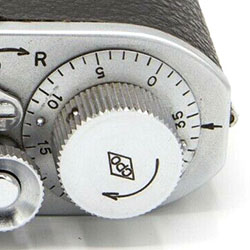
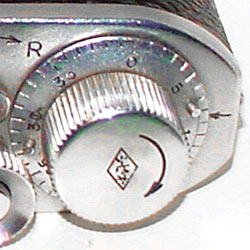
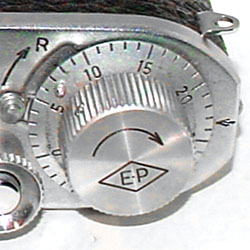
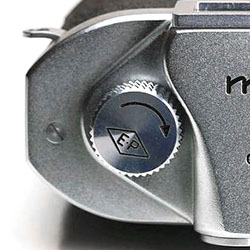 (Details from larger web images)
(Details from larger web images)
Note: At least one site claims that the issue of the 7 sprocket hole frame spacing for automatic slide cutting machines stopped military Exchange store sales. It was an issue for Exchange stores but the main obstacle was that SCAP (or his support organisation, GHQ, FEC) barred exports of non-compliant products at a time when only export production was permitted, with some minor exceptions (there is a problem with reconciling that statement with the fact that there does appear to have been over 3,000 non-compliant Minolta 35 Models A & B produced, presumably the ban came into effect after the problem was identified - Chiyoda Kōgaku was the first with the Japanese format). As I mentioned above, there are Model A & B examples with the <CPO> mark, in fact four of them.
Presumably as a bit of additional brand marketing, Chiyoda Kōgaku added a “Minolta Camera” and logo adhesive label to the camera backs of some Minolta 35 models and I have also seen it inside some Minoltaflex TLRs from the early 1950s. On the Minolta 35 Model II type a2 back below, the adhesive has failed and there is tape on one end holding the label in place, after 70 years, probably a very common occurrence:
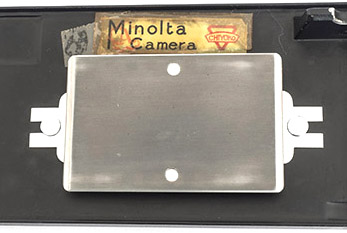
It is still there on two other type a2 examples, plus there are remnants of adhesive on a fourth. The cameras fit between serial numbers 49633 (with the featured back) and 5301x of Model II type a2 cameras in my database (roughly, the first third of the serial number range for the a2) and haven't been found on later models. There is one on an earlier Model II type a1, one on a Model F and four on Model E examples but none found earlier.
Models
Like many, maybe most Japanese camera makers of the era, as Chiyoda Kōgaku thought of refinements, it applied them to the next cameras on the production line without waiting to release a new model or version. This was the way Minolta operated into at least the mid-1960s and Yashica was the same and with its TLRs, continued this way until their demise in 1986. Also Leotax and Nicca, with their stamped bodies but not with the die-cast models from the mid-1950s on.
Officially, there was only the original Minolta 35 and following Minolta 35 Models E, F, II and IIB. Collectors and historians like to classify things and they have worked backward from the Model E and allocated A, B, C and D to the plain Minolta 35 to coincide with the bigger feature changes. However, there were more variations than that so they have also split up some models, except for the E, F and IIB, into types. Not everyone agrees with everyone's views and some like to be more granular and others less so there are variations but by and large, collectors use the book “Leica Copies” by Hans P. Rajner and the work done by Minolta expert Andrea Aprà as the basis for model classification. I'm also informed by the Collection Appareils website which credits both Andrea Aprà and Wolfgang Huller in conjunction with the Minolta Manual Focus Collector's Society.
Note: Most collectors and historians have broken up models by “type” and lower case letter, e.g. “Model A, type a” and then added numerals if required. When I started, I didn't want to be constrained by how others have defined the variations so to avoid confusion, I used something different and what is comfortable for me, “version” and numeral. In the end, except for some minor differences, my model variations looked much like everyone elses' so for consistency, I have aligned my variations with those of Andrea Aprà and the others. Although I don't like models and variations both being defined alphabetically but rather than reinvent the wheel and confuse people, I have also decided to adopt the alphabetic classification system. I may have missed some instances on my page and the existing links will still refer to “version” rather than “type”.
Models Table
The models and types are summarised in the table below together with the serial numbers of examples I have found (i.e., actually seen, seen in photos or in one case, seen reliably quoted). With the earlier Models A to D particularly, the numbers found are quite small and the serial number ranges they fit in usually much larger, however, together with the camera's feature set, it should be clear what model it is. Examples of cameras/features and other details are below the table.
| Mod. | Type | Year | Maker Name | Frame (mm) |
Serial No.s Found |
Principal Change/s |
|---|---|---|---|---|---|---|
Standard lens: f/2.8 45 mm |
||||||
| A | a |
1947 |
CHIYODA-KOGAKU OSAKA |
24x32 |
027x-029x |
No strap lugs. Slow dial screw. Slow dial read from front, not top. Leica type rewind release. |
| A | b |
1947 |
CHIYODA-KOGAKU OSAKA |
24x32 |
052x-077x |
Film counter mark position moved to side |
| A | c |
1947 |
CHIYODA-KOGAKU OSAKA |
24x32 |
095x-144x |
Slow speed dial lock removed. Shutter progression changed, 1/5 becomes 1/4, 1/10 becomes 1/8 |
| B | a |
1947 |
(blank) |
24x32 |
1482-1516 |
Small no., maybe 50, claimed to have no maker name |
| B | b |
C.K.S. |
24x32 |
174x-284x |
Maker name change |
|
| C | a |
1948 |
C.K.S. |
24x33 |
400x-480x |
Film advance by 8 instead of 7 perforations (36 frames instead of 40). Frame size increase |
| C | b |
1948 |
C.K.S. |
24x33 |
513x-860x |
Slow speed dial numbers turned upside down to enable reading from above |
| D | a |
1949 |
C.K.S. |
24x33 |
910x-1059x |
Strap lugs added. Rewind release lever moved under counter. Depression in front panel under lens |
| D | b |
1949 |
C.K.S. |
24x34 |
1134x |
Frame size increase |
| E | 1951 |
C.K.S. |
24x34 |
1518x-1752x |
Model name on front. Diopter adjustment. Flash sync socket on back (not PC type) |
|
| F | 1952 |
C.K.S. |
24x34 |
2139x-2539x |
Different flash sync socket on back (still not PC type). Self-timer numbers “1, 2, 3” added |
|
| II | a1 |
1953 |
C.K.S. |
24x34
|
3536x-4914x |
Early body still. Slow speed dial loses centre screw. New raised lock on base plate also opens/closes Minolta film cassettes. Sync now PC type |
Standard lens: f/2.8 45 mm or f/2 5 cm |
||||||
| II | a2 |
1953 |
C.K.S. |
24x34
|
4903x-5940x |
Red “X” added to slow speed dial between 8 and 25. f/2 lens added |
Standard lens: f/2.8 5 cm or f/2 5 cm |
||||||
| II | b1 |
1955 |
CHIYODA KOGAKU |
24x34
|
7012x-8953x |
New top & bottom plates. Plain accessory shoe still. Maker name change. f/2.8 5 cm lens replaces 45 mm. Film plane mark added |
| II | b2 |
1956 |
CHIYODA KOGAKU |
24x34
|
8633x, 8916x-10182x |
New accessory shoe with pressure balls. New cast shutter cover with machined guide rails |
Standard lens: f/1.8 5 cm |
||||||
| IIB | 1958 |
CHIYODA KOGAKU |
24x34
|
10501x-11397x |
Adds lever wind, Canon like black shutter and slow dial trim. New self-timer lever. New f/1.8 lens |
|
(Note: For several models above, the same version may have more than one serial number range.)
Model A
The example immediately below is a Model A, type b. It is typical of the general appearance until the later versions of the Model II introduced a new top plate and matching bottom plate design. Although it changed noticeably with the Model E, the polished chrome viewfinder surround remained a feature to the end of the Model F. The standard lens is the f/2.8 45 mm that was the mainstay for much of the camera's life, note this early version has an aperture window just to the right of the © at the 12 o'clock position. The © indicates that the lens is coated:
 (From larger web image)
(From larger web image)
The top plate below belongs to an earlier Model A, type a. The only difference is that on the Model A, type b, the arrow index mark for the frame counter near the “R” of the film release moved to the right hand end of the top plate:

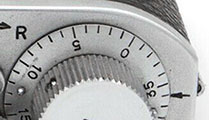
(Left detail from Massimo Bertacchi's “Innovative Cameras”, right detail from larger web image)
Other details to take note of are, left to right:
- The rewind knob shaft is visible in the centre of the knob.
- The centre pressure ball of the accessory shoe. This is a flashgun contact, i.e. an early form of hot shoe (see Flash Synchronisation and Model A user manual below).
- The shape of the platform under the shutter dial which remained unchanged until the new top plate arrived with the Model II type b1.
- The slow speed shutter dial lock. This was about to be removed on the Model A type c.
- On a Leica and most copies, the slow speed shutter dial numbers are the right way up when reading from above, on the Minolta 35 they are upside down but appear correct when viewed from the front. This changed with the Model C. However, the earliest lenses also read the aperture, distance and DoF from the front rather than above (see the DoF scale in the first image above) - this seemed to change during the Model B.
- Although oversized and operating in the reverse direction to the Leica, the rewind release lever was fairly typical of the genre but it would change.
On the Model A, type c, the slow speed shutter dial lock was removed, never to return. Also the shutter speed progression changed from T, 1, 2, 5, 10, 25/B, 25-1, 35, 50, 100, 200, 500 to T, 1, 2, 4, 8, 25/ B, 25-1, 35, 50, 100, 200, 500, i.e., 5 became 4 and 10 became 8, there would be no other changes to the progression apart from the addition of a red “X” between 8 and 25 part way in the Model II series.
Earlier dial on left with lock and speeds of 5 and 10, later dial on right without lock and speeds of 4 and 8 instead:
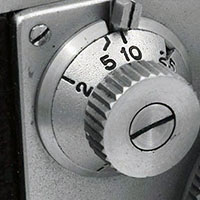
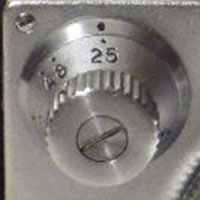 (Detail from larger web images)
(Detail from larger web images)
The pressure plate remained the same through to the end of the Model II type a 1 and into the start of the type a2. The back with the flat plate with circular cut out (almost side on, top right corner of image) which locks the film cassette spindle in the down position remained broadly similar through to end of the Model F, although the plate seemed to become thicker at some point, note the thicker corner reinforcing piece below the locking plate:
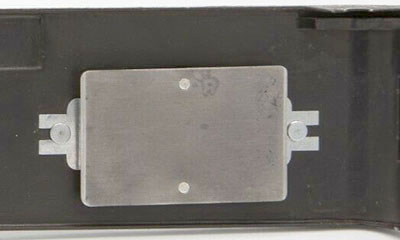 (Detail from larger web image)
(Detail from larger web image)
Below is a small version of an instruction sheet in English for the Model A - the slow speed shutter dial lock is both shown and featured as “F Slow Lock Button”. There is a link below the photographs on the Collection Appareils page to a full size PDF version (the actual sheet is on Italian enthusiast Massimo Scotti's website, massimoscottinelweb.com, but is a little hard to find). This may have been the only form of user manual in 1947, see Model C for a Japanese version:
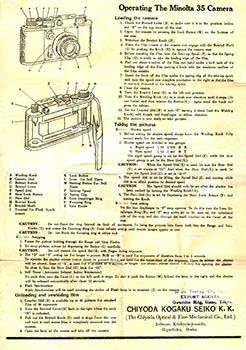
Model B
The only difference between Model A, type c, and Model B is the maker name. The Model A name was “CHIYODA-KOGAKU OSAKA”. The Model B, type a, is claimed to have no maker name at all. Details are on the Collection Appareils website including photos of the camera acquired by recognised Minolta expert Andrea Aprà. A second camera is also known, the two serial numbers are 1482 and 1516. According to the website, it is estimated that they are part of a small batch of maybe 50 cameras or so. The nameplate area of 1516:
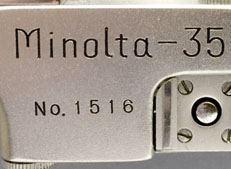 (Detail from Collection Appareils)
(Detail from Collection Appareils)
Model B, type b, introduces the maker name “C.K.S.” which is the abbreviation for the full company name Chiyoda Kōgaku Seikō.
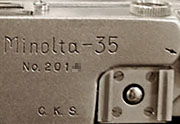 (Detail from larger web image)
(Detail from larger web image)
The internal shutter cover of the Model B below is the same as the Model A and largely the same all the way through to the end of first version of the new body type of the Model II (except for top row screw placement). It is a pressed brass plate incorporating pressed film guides. On some examples, the paint on the guides has worn through. The machined alloy guides of the late Model II and IIB look more impressive but it is not known whether the pressed guides are any less accurate.
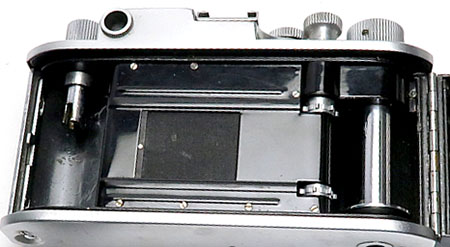 (Detail from larger web image)
(Detail from larger web image)
The Model B bottom plate is the same as the A and basically remained unchanged until the Model II. The back release is the recessed button on the left, a bit precarious for clumsy hands:
 (Detail from larger web image)
(Detail from larger web image)
The rewind knob on all Models A and most B examples had a hole in the centre for the shaft, as in the left photo below. The last two Model Bs in my database, 277x and 284x, feature the new type knob without the shaft hole, as in the photo on the right:
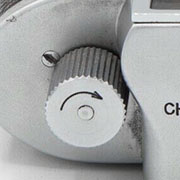
 (Detail from larger web images)
(Detail from larger web images)
Model C
Whilst the basic camera remained the same as the earlier models, there were several significant improvements. With the Model C, type a, the frame size was increased by 1 mm to 24 x 33 mm. At the same time the film advance was increased from 7 to 8 film perforations per frame. This meant that even though the frames were not as wide as the 36 mm Leica standard, the standard frame spacing worked with automatic cutting machines. As a consequence, the original 40 frames per 35 mm film cassette was reduced to the usual 36.
The opportunity was also taken to increase the viewfinder magnification from 0.33 to 0.7 and this improved the EBL from 13.2 mm to 28 mm substantially increasing focusing accuracy.
The back and pressure plate were still the same, this is a different view of the spindle locking plate and lower reinforcement:
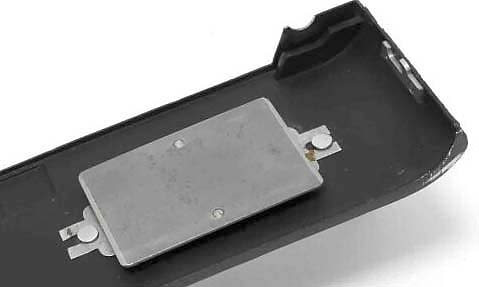 (Detail from larger web image)
(Detail from larger web image)
Model C, type b, dumped the odd idea of making the slow speed shutter dial readable from the front (see Model A above) in favour of the almost universal Leica inspired ability to read from above, i.e. from the shooting position:
 (Model C detail from larger web image)
(Model C detail from larger web image)
Below is a small version of an instruction sheet in Japanese for a slightly later Model/type than the English language one for the Model A. The heading translates as “Minolta 35” and “Instruction Manual” or “Instructions for Use” and the 4526 or 4826 serial number identifies the camera as a Model C. The full size document is downloadable from the Japanese Nikonfan website:
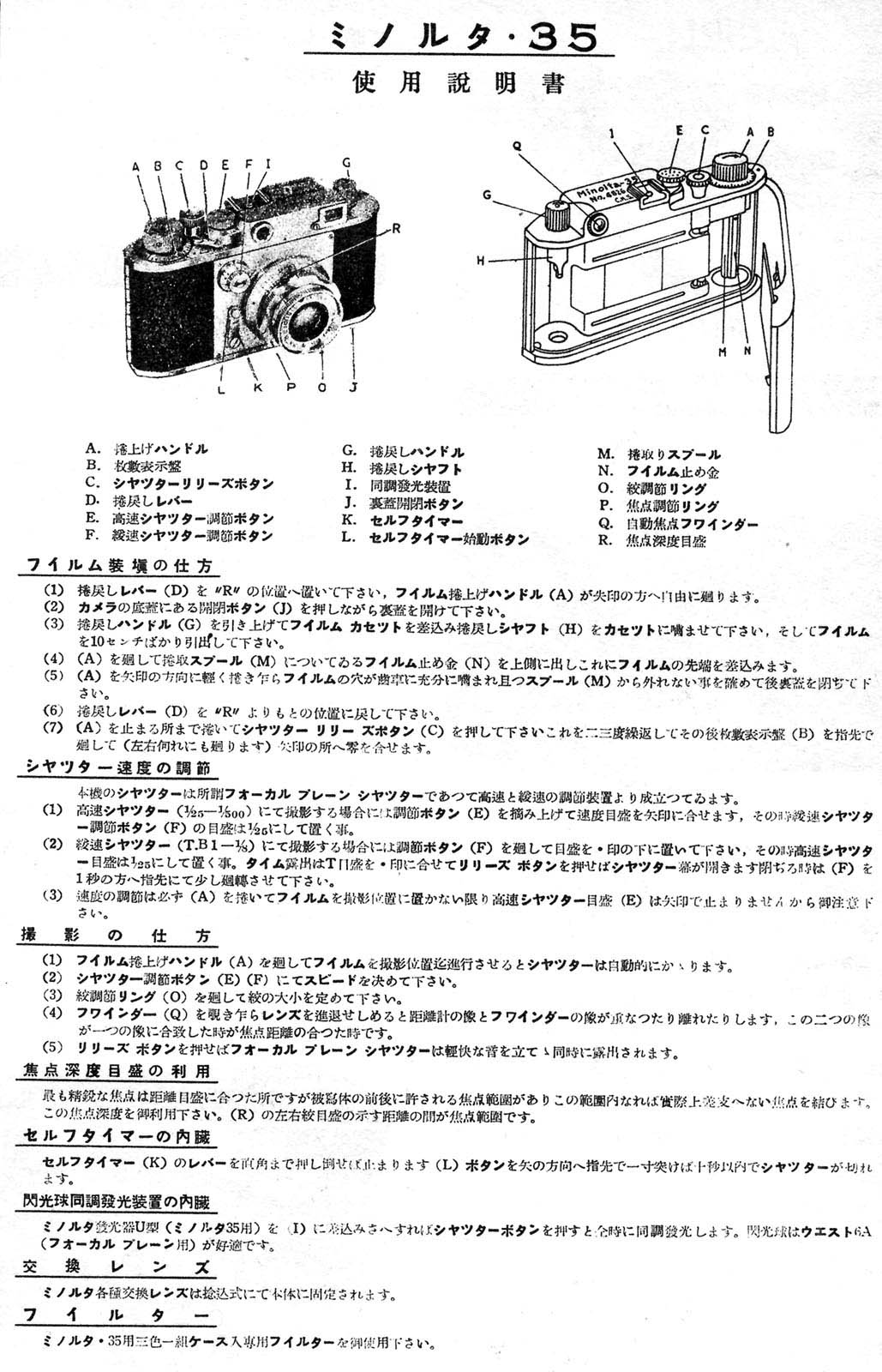
Model D
The Model D, type a, added strap lugs, moved the rewind release lever (see Model A above) to under the frame counter. A depression was added to the front panel under the lens, presumably to make it easier to use the focusing lever recently added to the lens. It doesn't really aid that so perhaps it was more of a design flourish?
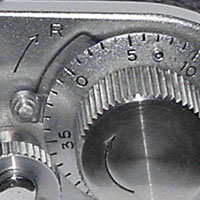
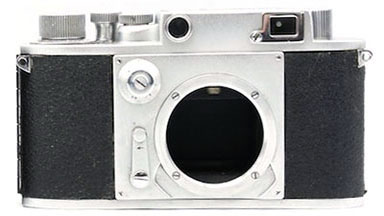 (Model D detail from larger web images)
(Model D detail from larger web images)
The Model D, type b, increased the frame size from 24 x 33 mm to 24 x 34 mm. I have found 13 type a cameras which fit into the serial number range of the smaller frame size but only one example with a serial number that belongs to the new larger size. The claimed production numbers are 1,900 of the first type and 1,500 of the second type so the second type examples should be out there in almost equal numbers but are incredibly elusive.
Model E
Asahi Camera ad from 1952 for various Minolta models including the 35 Model E and accessory lenses:
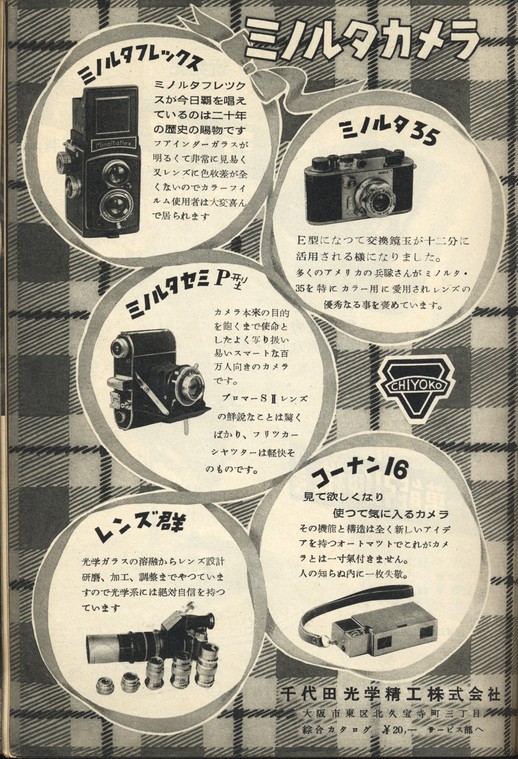 (Asahi Camera ad 1952)
(Asahi Camera ad 1952)
The Model E is noteworthy for being the first model with the name engraved (top right corner of front plate). It also added a diopter adjustment operated by rotating the eyepiece bezel and replaced the hot shoe and pressure ball with a plain type with the sync moving to an unknown socket type on the back (the lens cap shown is probably from a Model II). The viewfinder window is larger with a narrower frame than previous models - there was no magnification increase so presumably, there was a new optical system allied to the diopter adjustment:

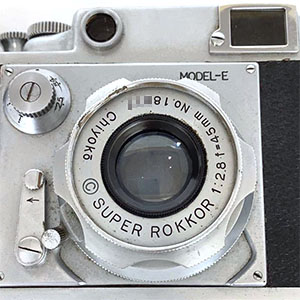
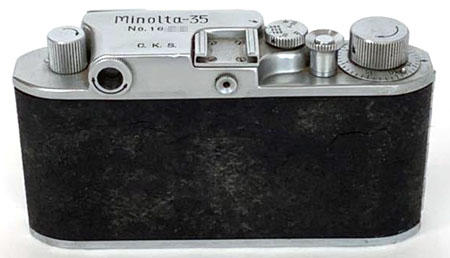 (Detail from larger web images)
(Detail from larger web images)
Model E brochure and user manual available for download from the Minolta page of the Pacific Rim Camera website:


The user manual only mentions two Minolta bulb type flashes, no details about the sync type or speeds. Presumably there is no X sync. As shutter speeds are not mentioned, presumably FP bulbs can be used at any speed.
Model F
It has been suggested by some that the Model F was a slightly updated version of the Model E made for the domestic Japanese market. That may be correct but then why was there an English language user manual (see below)? The Model F didn't change much; a new name, the red numbers “1, 2, 3” on the plate behind the self-timer, a red ring on the self-timer knob and a different flash sync socket. As noted in Flash Synchronisation above, the flash socket is still not a PC type:
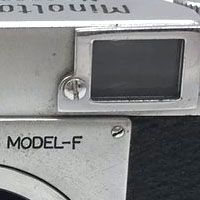
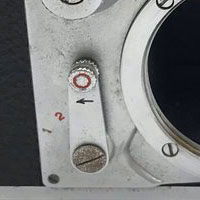

(Detail from larger web images)
The shutter cover and film guides are still the same as earlier models including screw placement:
 (Detail from larger web image)
(Detail from larger web image)
That extends to the back as well:
 (Detail from larger web image)
(Detail from larger web image)
The English language Model F user manual is almost identical to the Model E one, even the photos have been reused. Unhelpfully, the flash sync information has also not been updated even though both sync sockets are clearly different. It's available for download from the Minolta Collectors Facebook group:

Model II
There are four versions of the Model II divided across early and late bodies, type a and type b respectively. The early bodies are an evolution of the original Minolta 35, the late bodies are too but feature new top and bottom plates. Each is further divided into two sub-types by other changes.
The two examples below are a type a2 on the left and a type b2 on the right, illustrating the main differences in appearance between the original look of the Minolta 35 and the new look which culminated in the Model IIB. Both feature exactly the same dimensions and are 4 mm taller than the Model E height specified by Minolta (see table). At least 3 mm, perhaps slightly more, is in the addition of the new back lock knob and tripod pedestal on the base plate (see Type a1 below). The smaller viewfinder window (and wider frame) of the later body is to do with the narrower angle of view of its 5 cm lens (explained further below):
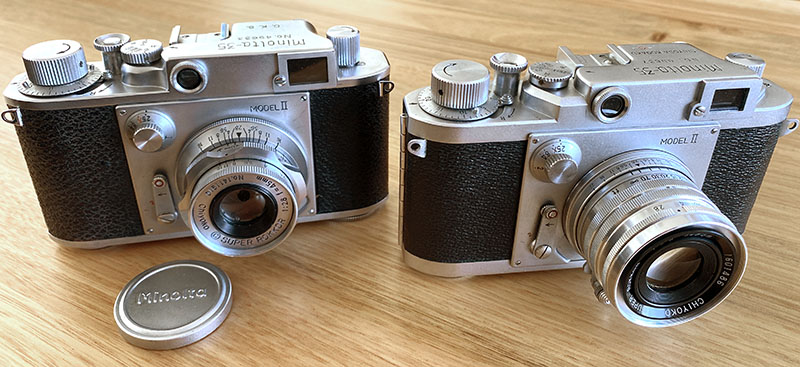
Both feature f/2.8 lenses, last version of the 45 mm on the left, new 5 cm on the right.
Model II, type a1
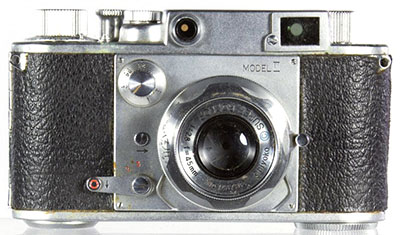 (Detail from larger web image)
(Detail from larger web image)
Type a1 of the Model II is still basically the same body as earlier models. It eliminated the large centre screw of the slow speed dial, finally introduced a PC sync socket and debuted a new back lock on the bottom plate. This necessitated adding a similar size pedestal under the tripod mount so that the camera would sit flat and stable on its bottom:
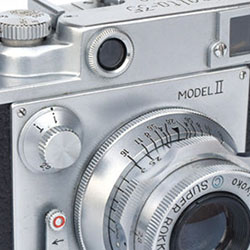
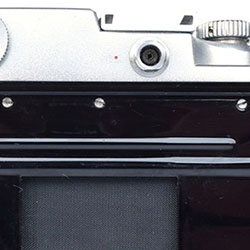
 (Detail from larger web images)
(Detail from larger web images)
The oversize back lock, whilst more secure than the earlier type, also had a second purpose, possibly its main role, and that was to open and close the new Minolta reusable film cassette. This was based on the the newer Zeiss Ikon design rather than the Leica type. More in Accessories. The earlier bodies made no provision for this and that would have been a minus with some potential buyers. The lock and casette are on page 4 of the user manual below (cassette operation described on page 10):
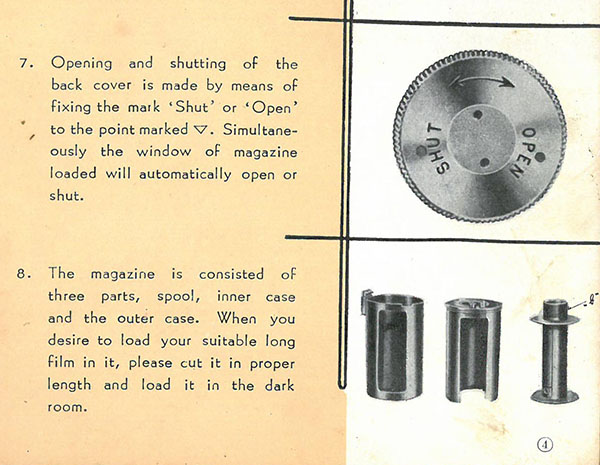
The hinged back was revised with a new metal black band top and bottom. On the inside, the spindle locking plate was lowered from the top edge and combined with the reinforcing piece to match up with a new spindle profile (see Types b1 and b2 below), however, this seems to have occurred part way through production of this version as some examples, including the shutter cover example below with the early spindle, still feature the locking plate at the top edge:
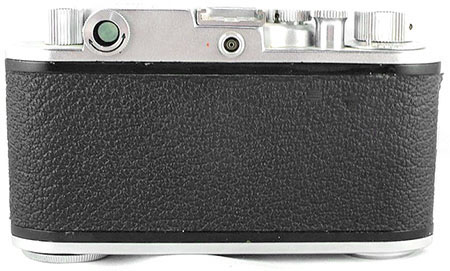
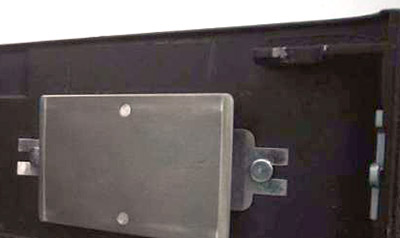
(Detail from larger web images)
The only change to the early style shutter cover is that the third screw from left on the top row has moved up from the end of the top guide:
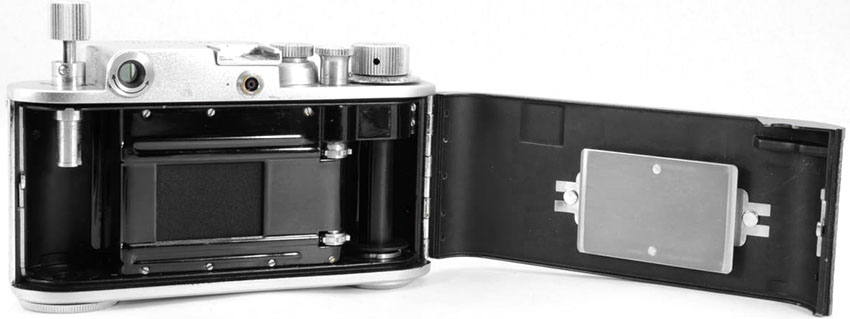
(Detail from larger web image)
The viewfinder frame changed from polished chrome to satin chrome to match the top plate finish but the window and frame appear to remain the same size as the Models E and F (at least one example in my database is still polished chrome but it is not known whether that is original or not). The window width is 13.5 mm:
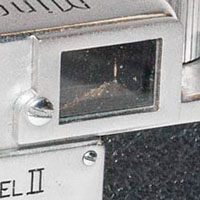 (Detail from larger web image)
(Detail from larger web image)
Model II, type a2

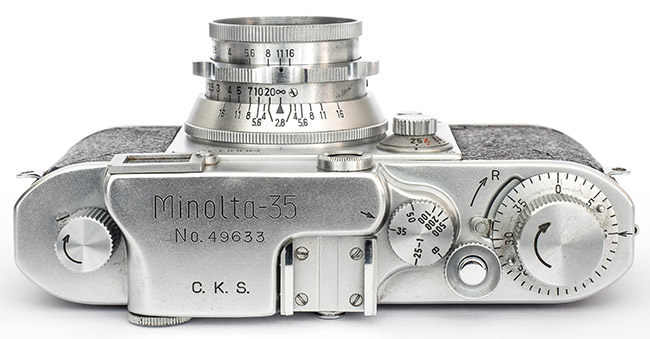
The only visible external change to the body brought by the type a2 was the addition of a red “X” between the 8 and 25 on the slow speed dial signifying X sync for electronic flash. The X sync speed was 1/25. Details are on page 9 of the user manual below which is downloadable from Flynn Marr Photography.
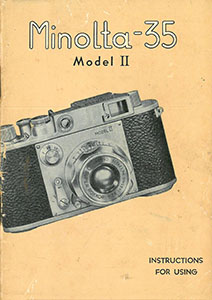
The same manual is available from Michael Butkus at OrphanCameras.com and the Japanese version from the Minolta page of the Pacific Rim Camera site.
The earlier examples up to serial number 5238x mainly still featured the original style pressure plate. Note also the “Minolta Camera” label on the example below (tape on one end assisting the failed adhesive). The label has been found on Model E to Model II type a2 cameras up to serial number 5301x, see Made in Occupied Japan, Other Markings & Labels. This back belongs to camera 49633 featured above and below:
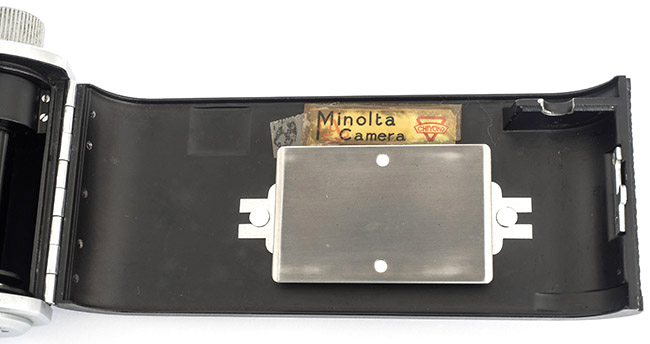
The featured camera is also the one which I measured for the The 0.5 mm Debate. To me, it certainly looks more like 34 mm than the 34.5 mm Chiyoda Kōgaku sometimes claimed for the Model E:
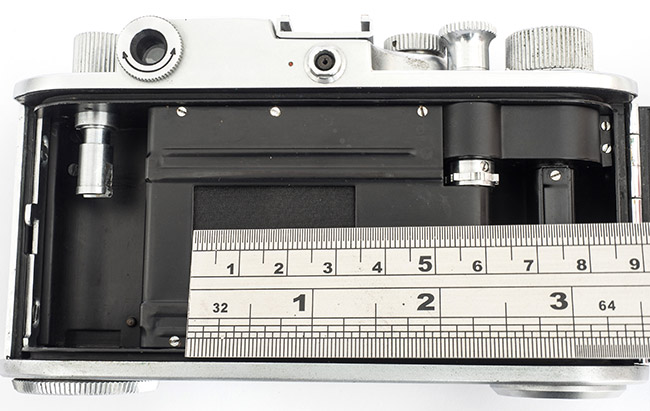

Starting with serial number 5068x, a new longer and dimpled black pressure plate began appearing:
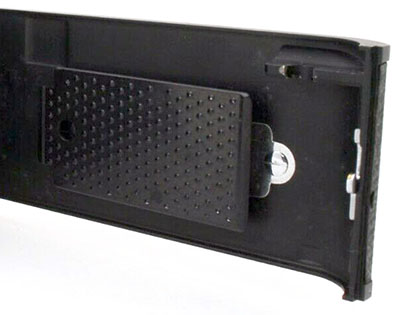 (Detail from larger web image)
(Detail from larger web image)
The type a2 also marks the first availability of the new f/2 5 cm standard lens. The previous f/2.8 45 mm lens was still available and not yet replaced by the new f/2.8 5 cm - that was still to come. In my database are 10 type a2 examples with the f/2 lens and 9 with the f/2.8 45 mm so it was popular straight away. However, note that even though the above English user manual features the red “X” on the slow shutter dial already, as does the example below, the f/2 lens is not featured in the manual nor is it listed as one of the lens options but it is in the Japanese version of the same manual which must be from a little later, or it wasn't offered outside of Japan, at least initially:
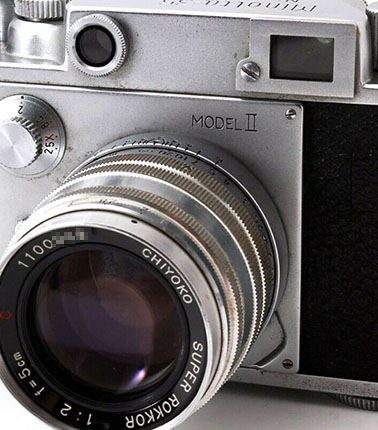 (Detail from larger web image)
(Detail from larger web image)
Note: Examples fitted with the 45 mm lens have the same viewfinder window size as the type a1, 13.5 mm, see type a2 photo at beginning of this section. Examples supplied with the new f/2 5 cm lens, as in the photo immediately above, have a smaller viewfinder of 11.5 mm width to adjust for the narrower angle of view. The overall frame width, minus the adjusting screw bump, is 20 mm on both. I presume that the optical systems are identical and the wider frame of the window acts like a mask.
Model II, type b1
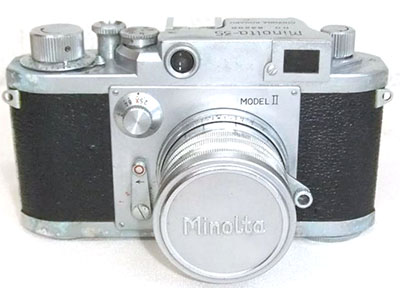 (Detail from larger web image)
(Detail from larger web image)
The 1955 Minolta 35 Model II, type b1 brought the first new look to the body (see Type b2 for more photos) with the top plate and bottom plate both featuring a deeper lip around the edge, the main shutter dial platform taking on a wider, more angular and dare I say, a more Leica-ish look as well as a triangular platform under the rewind knob, again, not unlike the Leica IIIc/f. As well as looking more modern, some suggest that it is a stronger body, the design changes certainly give that impression. Of course, it may just all be cosmetic, I have seen no evidence of structural changes to the body.
Although the f/2 lens had already arrived with the type a2, the type b1 introduced the new f/2.8 5 cm lens which would eventually completely replace the earlier f/2.8 45 mm. Initially however, there were still some 45 mm lenses to be used up and these were fitted to a small number of early b1 examples. The bodies, whether still with their original lens or not, are easy to identify - they feature the larger 13.5 mm viewfinder window.
Two items that didn't change until the next version are the shutter cover and accessory shoe:
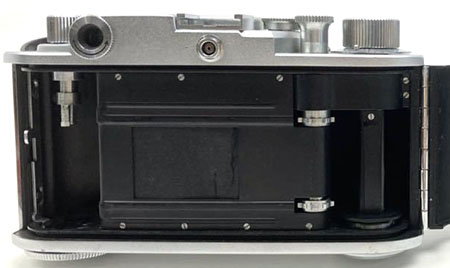
 (Detail from larger web images)
(Detail from larger web images)
The type b1 and its available lenses feature in this Japanese brochure from about 1955:
Model II, type b2
The final version of the Model II introduced an accessory shoe with two pressure balls and a completely new cast alloy shutter cover with machined film guides. According to the Collection Appareils website, it was introduced in 1956. The distribution of 5 cm lenses in my database for both Model II types b1 and b2 is roughly half and half, f/2.8 and f/2. The f/2.8 lens on this camera example is not original to the body but they are the correct versions for each other, the body serial number from near the beginning of the type b2 and the lens serial number from near the end:
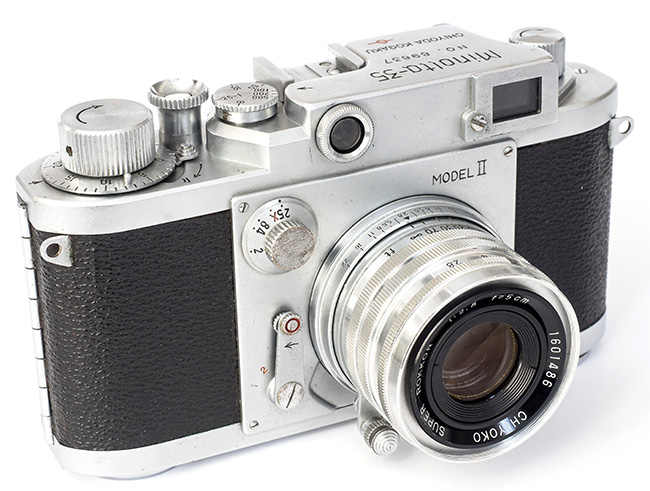
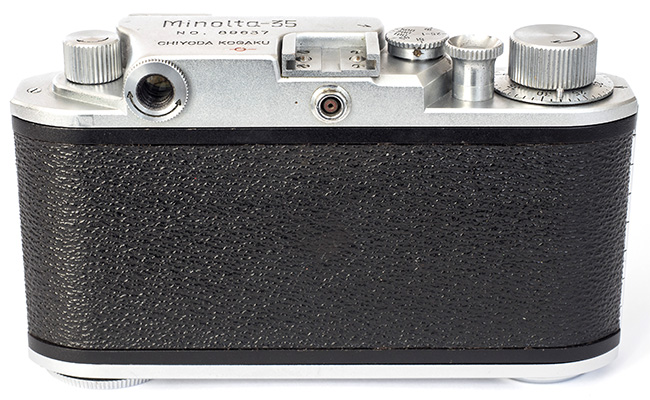
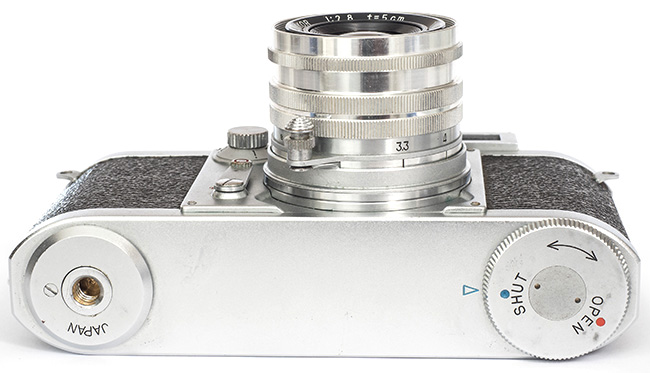
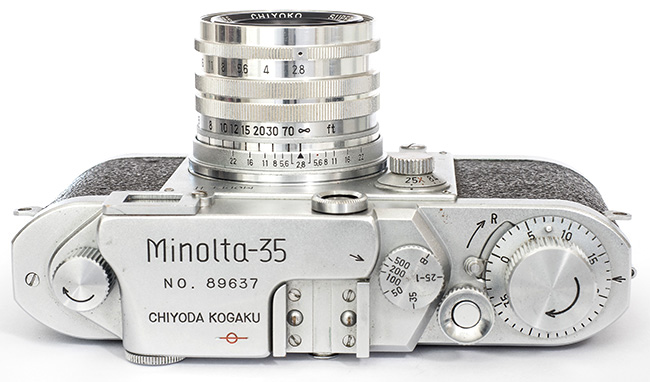
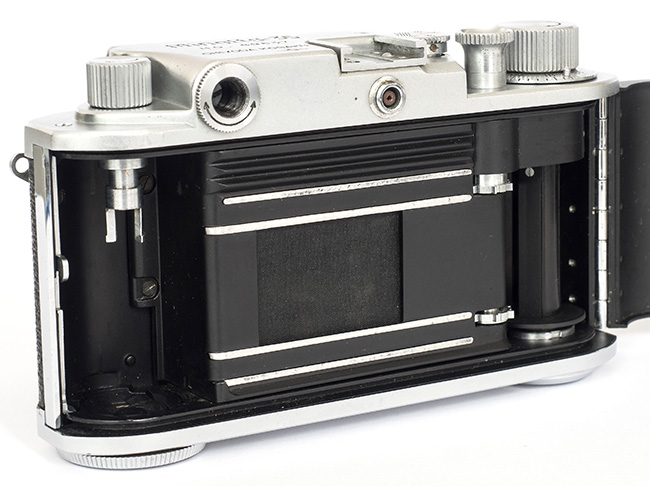
The pressure plate changed yet again, it was shorter than the type a2/b1 style and smooth instead of dimpled. The waist of the film cassette spindle which engages with the revised locking plate on the back, introduced during early type a1 production, is clearly visible on the left of the photo and also in the image above:

Type b2 examples in my database generally commence from 8916x. They are claimed to start at 87xxx, however, in amongst the type b1 examples is the camera below, 8633x. It has the accessory shoe with pressure balls and I can confirm it has the new shutter cover shown above. Its f/2.8 lens, 15067xx, is appropriate for the body number. There doesn't seem to be any fiddling going on with changed parts etc:
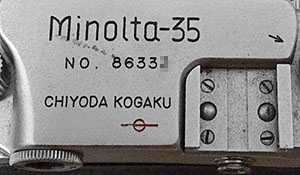 (Detail from larger web image)
(Detail from larger web image)
Below are some pages from the Japanese user manual for this version assembled from two separate manuals on auction sites:
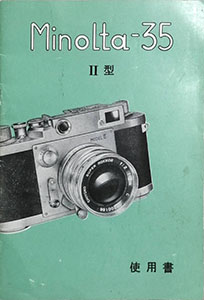 (Click on cover for PDF of select pages)
(Click on cover for PDF of select pages)
Note: Most of the photos/diagrams showing the accessory shoe are of the type b1 version.
Model IIB
 (Detail from larger web image)
(Detail from larger web image)
The Minolta 35 Model IIB was released in May 1958 but didn't seem to survive very long, some say 12 months, particularly with Chiyoda Kōgaku about to release the SR-2 SLR later in the year and a developing interest in leaf shutter rangefinder cameras, both fixed lens and the two interchangeable lens types, Minolta A-2 LT and Super A. It was basically the Model II type b2 body with the addition of lever film wind and the consequent move of the rewind release lever from under the frame counter of previous models. It also introduced a new Chiyoda Kogaku Super Rokkor f/1.8 5 cm standard lens, which replaced both the previous f/2.8 and f/2 lenses, as well as a new f/1.8 35 mm wide angle lens and a new f/3.5 100 mm telephoto lens, each featuring the new black body livery with chrome nose.
The black trim on the shutter dials is reminiscent of the Canon VT and L2 models released in 1956 whilst the Minolta name was now all lower case in the style that would last until the rising sun logo appeared on Minolta cameras from 1981 onward. Interestingly, its lens hood and box (both further down) feature the earlier style name - perhaps it was a sudden change?
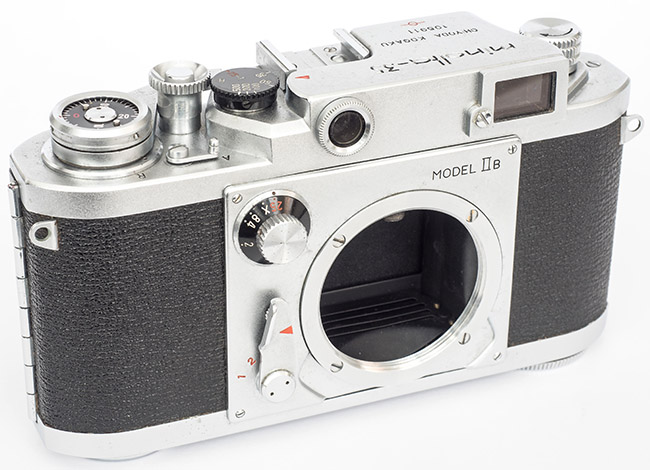
The viewfinder magnification was increased to 0.8x giving an EBL of 32 mm. The eyepiece appears to be physically larger, or at least that is the impression given by a narrower chrome bezel, but the diopter adjuster is gone. The viewfinder window is slightly larger than the preceding Model II versions with a correspondingly narrower frame:
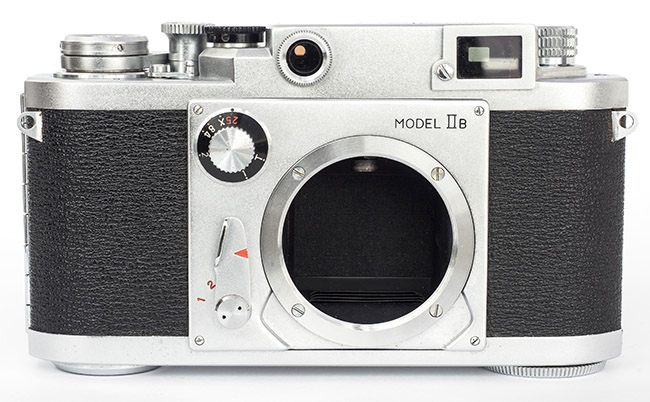
The knurling on the film rewind knob now featured two horizontal rings and the self-timer lever also featured a new look.
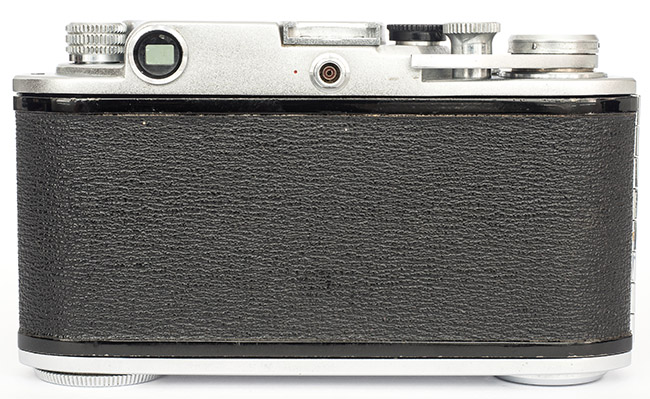
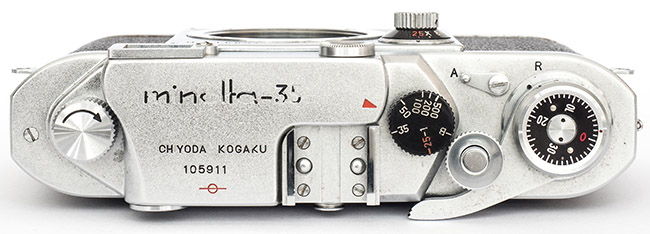
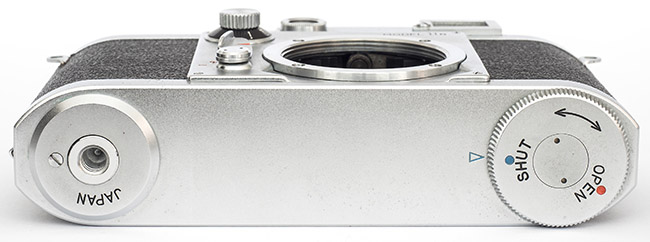
There was yet another change to the camera back, this time the addition of a roller to assist with film transport:
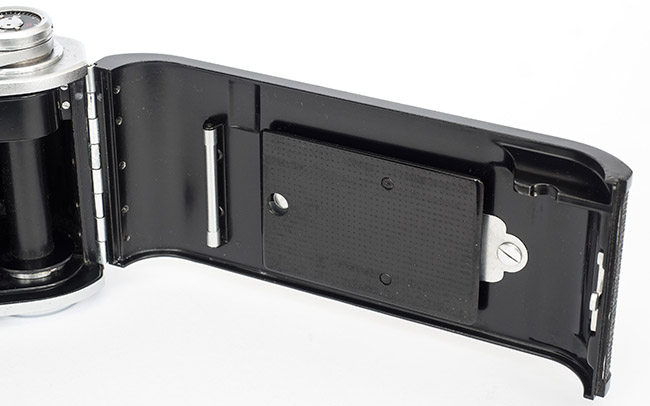
As noted in The Format Wars, there is a widespread belief that the frame size finally increased to the Leica standard of 24 x 36 mm but this is contradicted by Swiss collector Renaud Laemmli on Sylvain Halgand's Collection Appareils site (use French version of the page). My measurement of my example confirms that frame size remains no wider than the earlier claimed 34 to 34.5 mm measured and advertised sizes and actually looks pretty close to 34 mm:
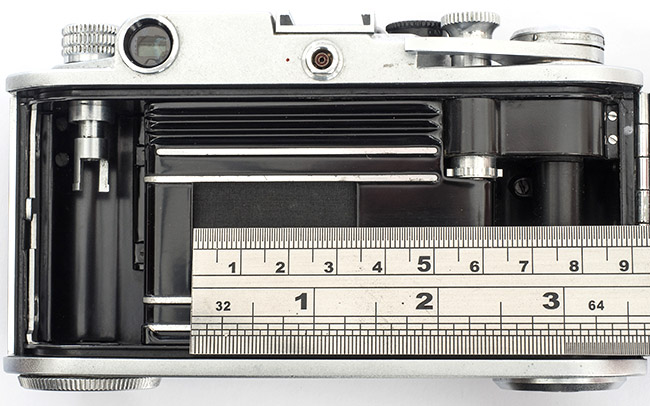

Whilst the Minolta 35 Model IIB was the last of the production LTM models, it's possible that a Model III was also being planned. This appears to have been a simpler LTM version of the SKY prototype, see SKY and Model III Prototypes.
The Lens Portfolio
The lens portfolio wasn't large but there were numerous permutations with cosmetic and feature changes and different serial number ranges, both with the supplied normal lenses and accessory lenses.
Earlier lenses all featured a © mark which indicates that they were coated. Probably from sometime in 1956 or 1957, the mark ceased to be used as virtually all lenses on the market were now coated and it was no longer of any marketing value. Nippon Kōgaku did the same with its Nikkors. Of the lenses with the mark, a blue © was used first on early lenses such as the f/2.8 45 mm, red was used on the later f/2.8 and f/2 5 cm lenses and some lenses started with blue and changed to red. Some of the blue © marks look black in photos, I suspect that earlier on, the blue was applied over black.
Note 1: Some lenses where marked in millimetres (mm) and others in centimetres (cm) but all were advertised in millimetres. My choice on this and other pages of the website has been to go with what is marked on the lens.
Note 2: Where
Chiyoda Kōgaku has quoted the angle of view of a lens, it appears to have been calculated based on the Leica 3 x 2 standard of 24 x 36 mm rather than the slightly smaller Minolta format. In reality, all LTM lenses will have a slightly narrower angle of view mounted on a Minolta body.
Standard Lenses
The table below identifies the four standard lenses in chronological release order, the feature and/or change which characterises the different versions, the serial number ranges of lenses I have found and the Minolta 35 models they are commonly found with (i.e., any obvious out of sequence lenses have been ignored). Below that are further specs, details and examples of each of the lenses.
Standard Lenses Table
| Serial No.s | Feature/Change | Models Most Found With |
|
|---|---|---|---|
From |
To |
||
| Chiyoko Super Rokkor f/2.8 45mm | |||
210x |
440x |
Aperture window, blue ©, scales read from front | A & B |
485x |
1437x |
Aperture window, blue ©, scales read from above | B, C & D |
9053x |
9054x |
Aperture window, blue ©, no focus lever, farthest distance mark 100 feet | C & D |
1179x |
1434x |
Aperture window, blue ©, focus lever | D |
1791x |
2107x |
No window, blue ©, focus lever, farthest distance mark reduced from 100 feet to 70 feet. | E |
13477x |
13990x |
No window, blue ©, focus lever, revised DoF scale | F |
140017x |
140948x |
No window, blue ©, focus lever, 19 mm filter thread omitted | II a1 |
141191x |
141690x |
No window, blue ©, focus lever, 19 mm filter thread omitted | II a2 & b1 |
Chiyoko Super Rokkor f/2 5cm (option)
|
|||
110022x |
110289x |
Red ©, f/16 min., 40.5 mm filter | II a2 |
120013x |
1201285 |
Red ©, f/16 min., 43 mm filter | II b1 |
130020x |
130318x |
Red ©, f/22 min., 43 mm filter | II b1 |
140035x |
140376x |
No ©, f/22 min., 43 mm filter | II b2 |
150024x |
150106x |
No ©, f/22 min., 43 mm filter | II b2 |
Chiyoko Super Rokkor f/2.8 5cm (option)
|
|||
150013x |
151147x |
Red © | II b1 & b2 |
160060x |
160406x |
No © | II b2 |
| Chiyoda Kogaku Super Rokkor f/1.8 5cm | |||
120032x |
120661x |
No © | IIB |
130134x |
130135x |
No © | IIB |
Chiyoko Super Rokkor f/2.8 45 mm
Lens schematic from Rokkor brochure on Minolta page of the Pacific Rim Camera site:
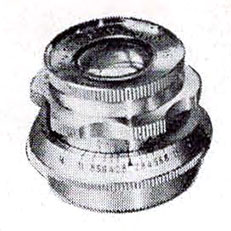
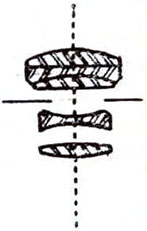
| Focal length | 45mm |
| Design | 5 elements/3 groups |
| f stops | f/2.8 - f1/16 |
| Angle of view | 51° (*1) |
| Aperture blades | 9 |
| Filter thread | 34mm, 19mm (*2) |
| Close focus | 1m, 3.3ft |
| Dimensions (dia. x length) | 48mm x 31mm (*3) |
| Weight | 160g, 186g (*4) |
Note *1: The angle of view of this lens will be wider than the 45° of the two later 5 cm lenses, as reflected in the different window sizes of the Minolta 35 Model II, but unfortunately, Chiyoda Kōgaku didn't seem to quote that detail. The 51° in the table is the full frame (24 x 36 mm) equivalent reported by a review site, likely the same basis as used by Chiyoda Kōgaku.
Note *2: The outer filter thread is 34 mm on all versions. Except for the last version, the black retaining ring also has an internal thread for small 19 mm filters (see below).
Note *3:
A Rokkor lens brochure claims that the lens length is 38 mm. That must be a guess. Lens QA Works has measured the minimum overall length of its earlyish review example as 31.3 mm and my last type is the same (within my measuring limits). The maximum overall length of mine is 33 mm.
Note *4: The Rokkor Lenses brochure lists the weight as 150 g whereas Lens QA Works has measured it at 160 g on an electronic scale confirmed by a photo. Both are early versions. Mine is a late example, serial number 1411910, weighing 186 g measured on an electronic scale - it is missing its focus lever so the correct weight would be a few grams higher.
This is an interesting lens. It is lightweight and compact and Chiyoda Kōgaku probably planned it as a worthy competitor to the collapsible f/3.5 lenses of the day. With a larger aperture and extra element compared to the competition, it was hardly any bigger and Chiyoda Kōgaku made a virtue of the fact that it didn't have to be extended to be focused. The 45 mm focal length was shorter than the typical 50 mm standard lens but that was offset somewhat by the narrower angle of view resulting from the smaller image area of the earlier models particularly. Even the filter sizes were the same as some f/3.5 lenses. The inner 19 mm size can be famously found on the Leitz Elmar and also on the Konishiroku (later Konica) Hexar and the outer 34 mm size is also found on various f/3.5 collapsible and rigid lenses from the period (some are slightly larger at 34.5 mm).
All lenses, including the earliest examples, feature a blue © to indicate that the lens is coated. However, on some of the earlier lenses the © looks black. I don't think they were originally - on some of these, there are traces of blue and I suspect that the engravings on earlier lenses were filled in with black first and then blue added over the top with the blue worn off since.
During its long life from 1947 to 1955 or 1956, there were a number of changes made resulting in at least six versions:
Version 1: The first two versions featured an aperture window and no focus lever. Unusually, version 1 has the aperture, distance and DoF scales facing towards the front like the early slow speed shutter dial:
 (Detail from larger web image)
(Detail from larger web image)
Version 2: The only change is that the scales are now facing towards the back so that they can easily be read from above. Note the aperture window (next to the ©) and two sets of filter threads:
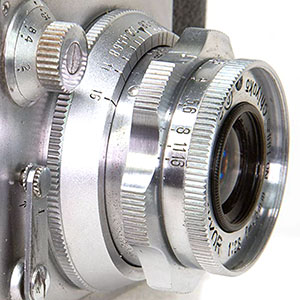
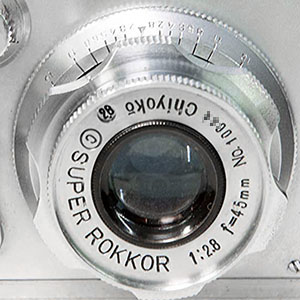 (Detail from larger web images)
(Detail from larger web images)
19 mm filter mounted:
 (Detail from larger web image)
(Detail from larger web image)
Most, not all, version 1 and version 2 lenses up to 693x in my database have a metric distance scale with 20 metres as the farthest distance before infinity. From lens 781x, most of the next lenses found feature distance scales in feet, although there is the odd metric example. In another unusual twist, the farthest distance in feet for version 1 and 2 lenses is marked 100 feet (20 metres is about 66 feet):
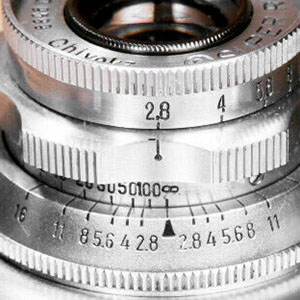 (Detail from larger web image)
(Detail from larger web image)
I have found three oddly numbered version 2 lenses with 5 digit serial numbers. When the serial numbers ticked past 4 digit 8xxx (presumably 8999), instead of the next number being 9000, it seemed to become 5 digit 90000, at least for a while. My database contains lenses 9013x (attached to a Model C type a), 9053x (attached to a Model C type b) and 9054x (attached to a Model D type b). The next lens in my database is back to 4 digits, 925x, as are the following lenses before naturally ticking over to 5 digit 1004x. Later versions of the lens without the aperture window, but with focus lever and with the farthest distance marked 70 feet, have 5 digit serial numbers maxing out at only 2107x (in my database) before 6 digit lens numbers were introduced:
 (Detail from larger web image)
(Detail from larger web image)
Version 3: Between serial numbers 1179x and 1434x some version 2 lenses feature a focus assist lever for the first time but that is not universal yet, e.g. lens 1437x found with a Model D is the last without it. Lenses with the aperture window still (i.e., in other respects version 2) and the focus lever are known as version 3:
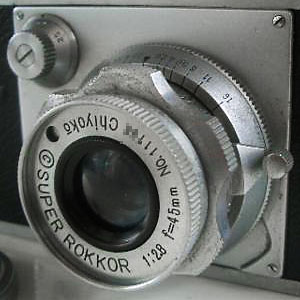 (Detail from larger web image)
(Detail from larger web image)
Version 4: This features the new focus assist lever of version 3, the aperture window on the front is omitted and the unusual 100 feet marking of version 2 is changed to 70 feet:
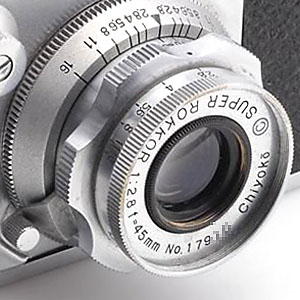
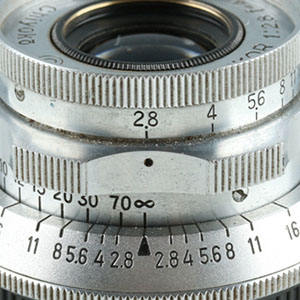
(Detail from larger web images)
Version 4 lenses seem to coincide with the arrival of the Model E.
Version 5: This seems to be an update introduced with the Model F release. The only obvious changes are the slightly revised depth of field (DoF) scale markings making it less cramped and easier to read and a new six digit serial number range:
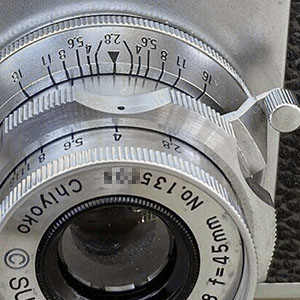 (Detail from larger web image)
(Detail from larger web image)
Version 6: The final version omits the 19 mm inner filter thread and features new seven digit serial numbers:
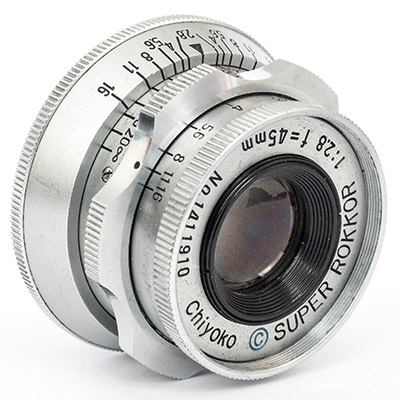
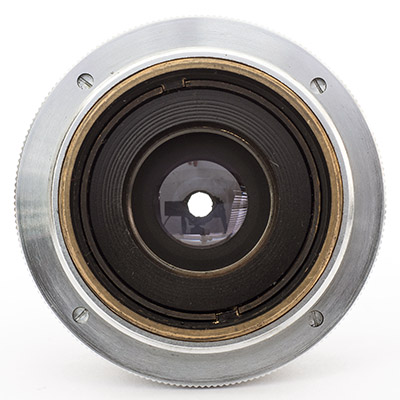
Whether coincidence or planned, serial numbers 140017x to 140948x belong to the Minolta Model II type a1 and 141191x to 141690x belong to Model II type a2. They could be separate ranges, or they could be one range and the numbers just ticked over from 1409999 to 1410000, which is more likely as it is doubtful that Chiyoda Kōgaku itself differentiated between type a1 and a2 cameras in any formal way.
Chiyoko Super Rokkor f/2 5 cm (option)
Lens schematic from Minolta Cameras brochure, the first 4 elements are in 4 separate groups with a narrow air gap between each element pair of the first two groups (the white lines):
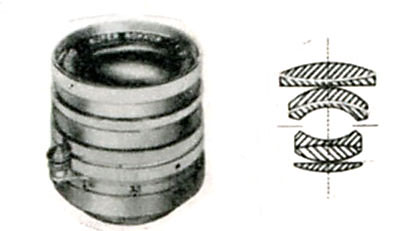
| Focal length | 5cm |
| Design | 7 elements/6 groups |
| f stops | f/2 - f/16 & f/22(*1) |
| Angle of view | 45° |
| Aperture blades | 10 |
| Filter thread | 40.5 & 43mm (*1) |
| Close focus | 1m, 3.3ft |
| Dimensions (dia. x length) | ? x 53mm (*2) |
| Weight | 260g (*3) |
Note *1: There were three physical variations; the earliest lens with smallest aperture of f/16 and 40.5 mm filter thread, the second with smallest aperture of f/16 and 43 mm filter thread and the third with smallest aperture of f/22 and 43 mm filter thread.
Note *2: Diameter unknown. Length is from Minolta Cameras brochure and presumably is the overall length.
Note *3: Weight is from Lens QA Works. Minoltas Cameras brochure claims 240g - it could be to do with lens versions, although there are some issues with weights of other lenses listed.
From the Japanese Minolta 35 Model II type a2 user manual (the thin black lines between the element pairs of the first two groups indicate an extremely narrow air gap and/or that the pairs are uncemented):
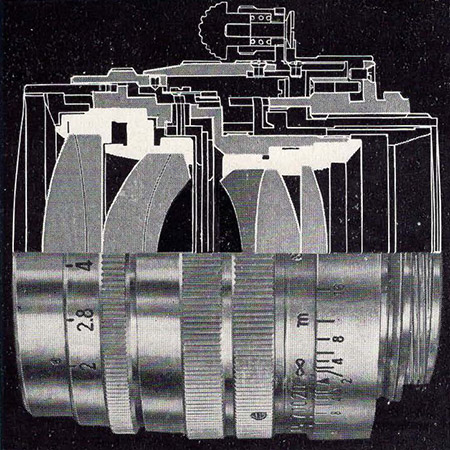
This lens was released with the Minolta 35 Model II, type a2 (first appearance of the red "X" on the slow dial). That model was offered with either the new f/2 or the earlier f/2.8 45 mm lens.
The first version of the f/2 has a 40.5 mm filter thread and a minimum aperture of f/16:
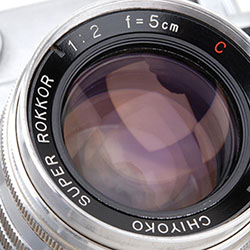
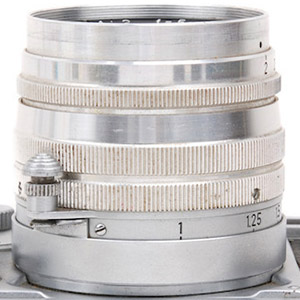
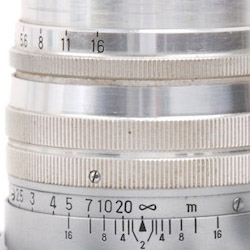
(Detail from larger web images)
The second version, on the left, introduced a 43 mm filter thread (note the ribbing on the outside of the now larger diameter front ring), still with a minimum aperture of f/16, the third version, on the right, increased it to f/22:
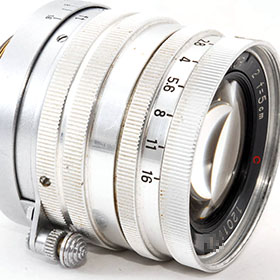
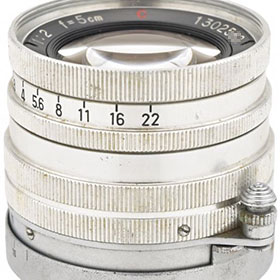
(Detail from larger web images)
The final fourth version is the same as the third version except that it omitted the red ©. There are two serial number ranges, 1400xxx (to 1403xxx in my database, probably goes higher) and 1500xxx (to 1501xxx, again in my database):
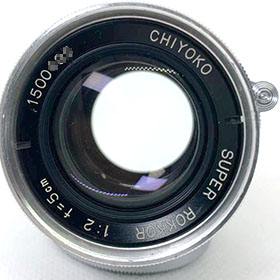 (Detail from larger web image)
(Detail from larger web image)
Note: Minolta 35 Model II bodies supplied with this lens, and also the coming f/2.8 5 cm, have a smaller viewfinder window (11.5 mm vs 13.5 mm) to compensate for the narrower angle of view than the 45 mm lens.
Chiyoko Super Rokkor f/2.8 5 cm (option)
Lens schematic from Minolta Cameras brochure:

| Focal length | 5cm |
| Design | 5 elements/3 groups |
| f stops | f/2.8 - f/22 |
| Angle of view | 45° |
| Aperture blades | 8 |
| Filter thread | 40.5mm |
| Close focus | 1m, 3.3ft |
| Dimensions (dia. x length) | 47mm x 43mm (*1) |
| Weight | 175g (*2) |
Note *1: The lens length of 43 mm is from the Minolta Cameras brochure and presumably is the overall length, with which I agree. Lens QA Works has measured the length as 37 mm, presumably to the flange at maximum extension, which would be about right.
Note *2: The lens weight is from Lens QA Works, I've measured mine at 178g. It's hard to know how the Minolta Cameras brochure has arrived at a weight of 230g.
This lens was released with the Minolta 35 Model II, type b1 (new look body), i.e. one version after the new f/2 lens. It replaced the 45 mm version which was then no longer offered, however, my database confirms that a small number of early type b1s were still sold with the last of the 45 mm production, the bodies still featuring the larger viewfinder windows.
The lens is the same optical design as the earlier 45 mm lens but has been updated and modernised. The focus lever is now also an infinity lock. There were no significant changes but the first lens range, 1500xxx to 1511xxx, featured a red © to indicate that it was coated, the second range, 1600xxx to 1604xxx, omitting it as no longer necessary. The earlier version:
 (Detail from larger web image)
(Detail from larger web image)
Later version without the the ©:
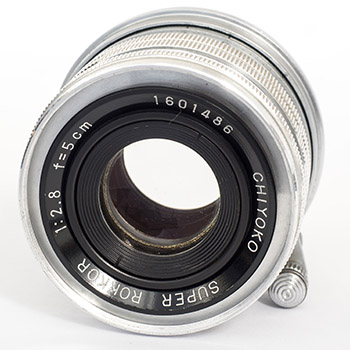
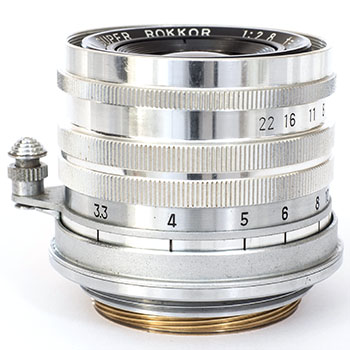
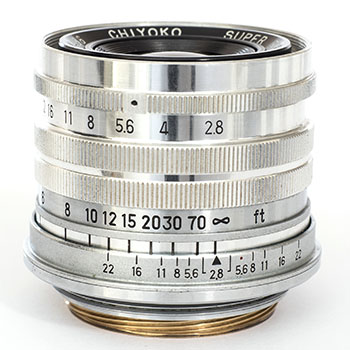
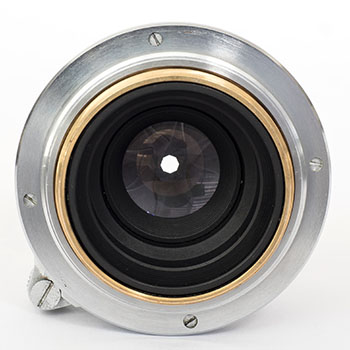
Chiyoda Kogaku Super Rokkor f/1.8 5cm
The Double Gauss optical design is similar to the f/2 5 cm lens except that the front pair has been replaced by a single element. The lens schematic is available from Lens QA Works.
| Focal length | 5cm |
| Design | 6 elements/5 groups |
| f stops | f/1.8 - f/22 |
| Angle of view | 45° |
| Aperture blades | 10 |
| Filter thread | 46mm |
| Close focus | 1m, 3.3ft |
| Dimensions (dia. x length) | 54 x 41mm (*1) |
| Weight | 260g (*2) |
Note *1: Lens dimensions are from Lens QA Works. I'm not sure what is being measured for length.
Note *2: Lens weight is also from Lens QA Works.
The f/1.8 5 cm lens has an updated appearance with black body and chrome bezel and a wide focusing ring dispensing with the need for a focus lever/infinity lock. By its release in May 1958, Chiyoda Kōgaku had stopped indicating that its lenses were coated. The only variation was that there two ranges of serial numbers, 1200xxx (to 1206xxx in my database, probably goes higher) and 1300xxx (to 1301xxx, again in my database):
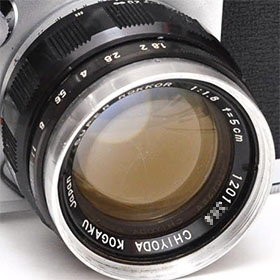 (Detail from larger web image)
(Detail from larger web image)
Accessory Lenses - First Edition
These are the accessory lenses that were available for the bulk of the Minolta 35's life from the original release (Model A) to the Model II. There was one wide angle lens and three telephoto lenses. The wide angle lens arrived considerably later, the telephotos first, near the beginning, so I will deal with them first. The lens schematics for the the telephoto lenses and the early examples are taken from the Rokkor Lenses brochure downloadable from the Minolta page of the Pacific Rim Camera site (the camera on the cover is a Model D released in 1949). The schematic and photo for the f/3.5 3.5 cm wide angle and late examples of the 8.5 cm and 13.5 cm lenses are from my Minolta Cameras brochure also featuring the Minolta 35 Model II type b1, so from about 1955, or maybe even 1956:
(Click on right cover for PDF)
Note, I have some doubts about the dimensions and weights quoted in the earlier brochure. These appear to be simply repeated in the later brochure even though the lenses have undergone updates.
Chiyoko Super Rokkor f/2.8 8.5 cm
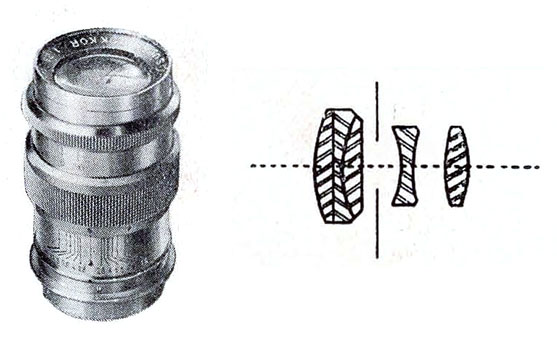
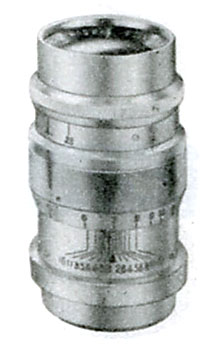
Circa 1949 lens on left, circa 1955-6 lens on right, difference explained below:
| Focal length | 8.5cm |
| Design | 5 elements/3 groups |
| f stops | f/2.8 - f/22 |
| Angle of view | 26° |
| Aperture blades | 10 |
| Filter thread | 40mm |
| Close focus | 1.3m, 4ft |
| Dimensions (dia. x length) | 48 x 79mm (*1) |
| Weight | 383g (*1) |
Note *1: Both brochures claim length is 76 mm and weight 370 g.
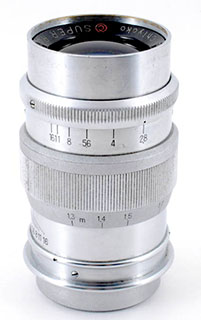
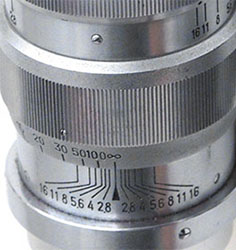 (Detail from larger web images)
(Detail from larger web images)
Earlier version distinguished by the ring above the protruding lens flange (all one piece with the lens mount), the later version features a thick, flat band (still part of the lens mount). Both versions feature a red © to indicate that they are coated. My database serial numbers for the first version run from 320x to 469x and 522x to 626x for the second.
Below is an earlyish ad from an earlier Larry Huffman Minolta 35 page, not the later page on his Canon Rangefinder Cameras site (also now defunct). The lens on the right is the 11 cm Tele Rokkor, he says the lens on the left is the 13.5 cm Tele Rokkor but I think that is incorrect, it has the stubby appearance with shorter bezel of the 8.5 cm Super Rokkor. I don't think that I have seen reference anywhere to a black and chrome version of the 8.5 cm lens and it is not known whether it ever made it to production or not:

Chiyoko Tele Rokkor f/5.6 11 cm

This lens doesn't appear in the circa 1955-6 Minolta Cameras brochure so presumably was discontinued. As far as I am aware, no late version without the © mark has been found. Although an unusual focal length in itself, it is close enough to other makers 10 cm and 10.5 cm lenses not to be remarkably different, however, the dark f/5.6 maximum aperture in the days of slow film certainly would not have made it a favourite.
| Focal length | 11cm |
| Design | 4 elements/2 groups |
| f stops | f/5.6 - f/22 |
| Angle of view | 20° |
| Aperture blades | 8 |
| Filter thread | 34mm |
| Close focus | 1.5m, 5ft/2m, 7ft (*1) |
| Dimensions (dia. x length) | 47 x 76 mm (*2) |
| Weight | 208g/244g (*3) |
Note *1: I have photos of a version 1 lens marked from 5ft and version 2 and 3 lenses marked from both 2m and 7ft.
Note *2: The Rokkor Lenses brochure lists an overall length of 76 mm. Collection Appareils quotes 69 mm for the minimum length of a version 2 lens, presumably to the flange, and Lens QA Works quotes 71.5mm for version 3.
Note *3: Similarly, Collection Appareils measures the version 2 lens at 208g and Lens QA Works the version 3 at 244g whilst the brochure, as is frequently the case, claims it is heavier at 270g.
The 5ft mark on the earliest version, the 2m mark on the black nose second type below can be seen just near its base:
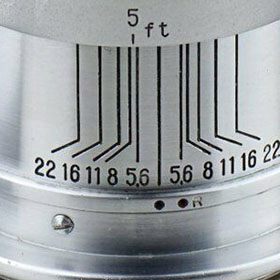 (Detail from larger web image)
(Detail from larger web image)
There are three versions of the f/5.6 11 cm lens. The first on the left below features the closer focus mentioned above, is all silver with silver beauty ring and black © to indicate that it is coated. My database serial numbers run from 305x to 354x. The second version has a black nose and black aperture and focusing rings. The © mark is blue. My serial numbers range from 330x to 360x indicating considerable overlap with the first version. The third version is all silver again but with a black beauty ring and red © mark. Serial numbers range from 470x to 549x.
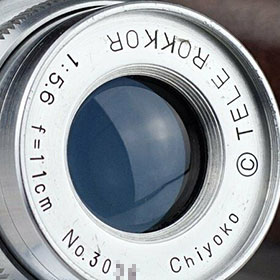
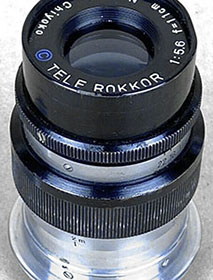
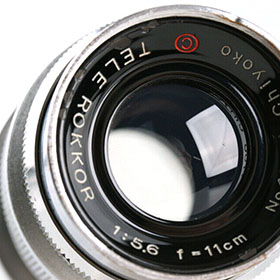
(Detail from larger web images)
Chiyoko Tele Rokkor f/4 13.5 cm
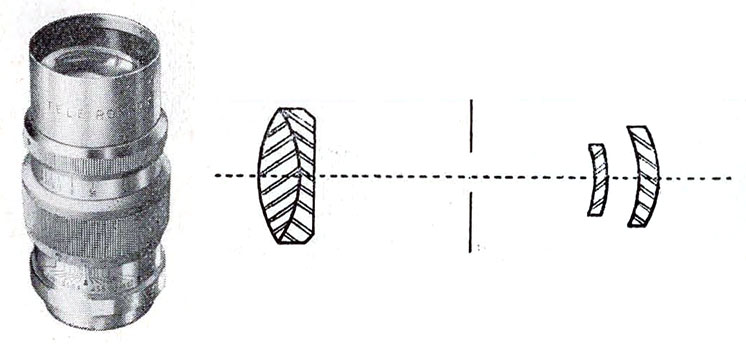
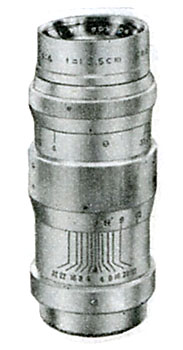
Circa 1949 lens on left, circa 1955-6 lens on right, differences explained below:
| Focal length | 13.5cm |
| Design | 4 elements/3 groups |
| f stops | f/4 - f/32 |
| Angle of view | 17° |
| Aperture blades | 10 |
| Filter thread | 40mm |
| Close focus | 2m, 6.5ft/2.5m, 8ft (*1) |
| Dimensions (dia. x length) | 48 x 98mm (*2) |
| Weight | 435g/472g (*2) |
Note *1: Lens QA Works tells us that there is a very rare first version with close focus of 2 m (6.5 ft). The rest focus down to 2.5 m (8 ft).
Note *2: Lens QA Works quotes a significantly lower weight for the earlier version 2 lens and a slightly different size, 50 x 97 mm, than Collection Appareils does for version 3. Both the Rokkor Lenses and Minolta Cameras brochures claim a weight of 520g and round the length to 10 cm.
Three versions of the f/4 13.5 cm lens are claimed to exist. The first is apparently very rare and is distinguished by a dull finished lens mount ring at the base. As noted above it has a closer focus ability than other versions. I have yet to see an example.
The first two photos are of version 2 lenses. These feature both a blue © (looks black in some photos of early examples) on the body above the aperture ring and a red © on the beauty ring (in the middle at the bottom of the photo). Serial numbers in my database range from 315x to 491x. The third photo is of a version 3 example. As with other similar vintage Rokkor lenses, the © mark no longer appears. The lens bezel has a slight step, both the aperture and focus rings have been redesigned, the latter losing the plain unribbed part of the ring and bevelled front edge. Serial numbers in my database range from 120020x to 120053x.
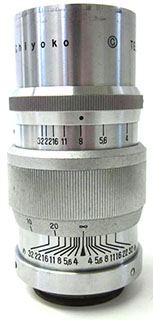
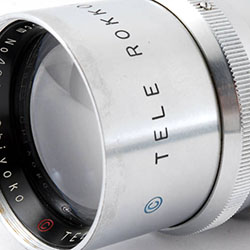
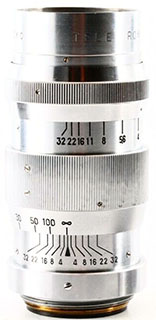
(Detail from larger web images)
Chiyoko Rokkor f/3.5 3.5 cm
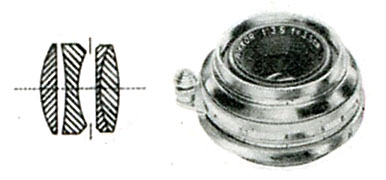
Several sites claim that this lens was launched in 1956. Its first appearances are in the Minolta Cameras brochure and the user manual for the Minolta 35 Model II type b1 so that timing is probably about right.
| Focal length | 3.5cm |
| Design | 4 elements/3 groups |
| f stops | f/3.5 - f/22 |
| Angle of view | 63° |
| Aperture blades | 6 |
| Close focus | 1m, 3.3ft |
It was late to the party and the specs were not a standout so it doesn't seem to have been very popular. It's not a very easy to find lens these days:
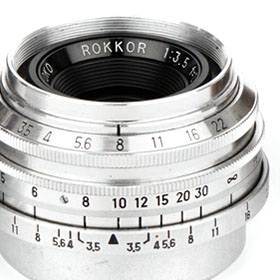 (Detail from larger web image)
(Detail from larger web image)
Mystery Lenses Circa 1951, Probably Unreleased
Below is a page from the English language Model E user manual (available for download from the Minolta page of the Pacific Rim Camera website), circa 1951, which displays the “Rokkor Lens Series”. The same page also appears in the circa 1952 Model F user manual, although admittedly, very little in that version was updated. The two mystery lenses are the short lens on the extreme left (left of f/2.8 45 mm standard lens) and the black lens with silver lens hood mounted on a “Minolta Teleflex” reflex housing fitted to a Minolta 35. The maker name “Chiyoda Kogaku” is under “Teleflex”:
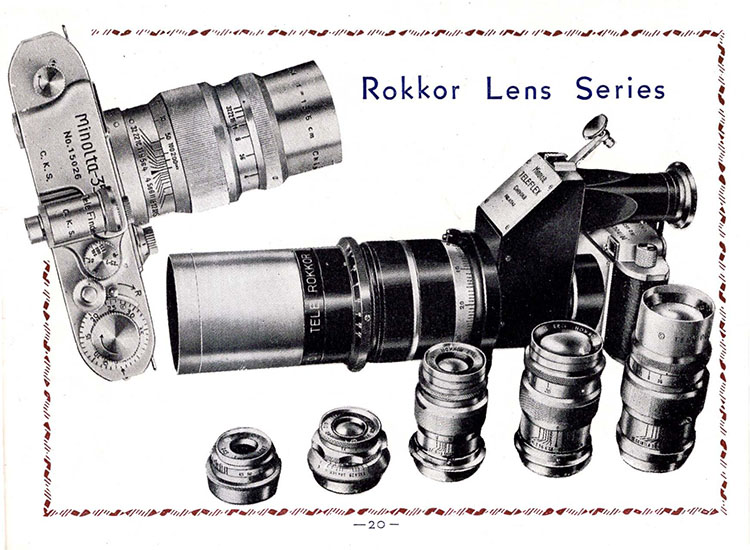
The black lens also appears in the Model E brochure downloadable from the same site (appears to be the same photo but the small lens is cut off in the circular image) and both appear (same photo again) in a 1952 Asahi Camera ad. There is no description, or even reference to, either of the two lenses or reflex housing in any Minolta documentation or references that I have seen. On page 18 of the Model E user manual, under the heading of “Accessories for Minolta 35” and the subheading “Interchangeable Lenses” are details of the other four lenses and on page 19 are examples of their coverage but nothing about the mystery lenses or housing.
The short lens is almost certainly a wide angle of some type. It has a different body design to the f/3.5 3.5 cm lens released in 1956 and from what I can make out, it seems to have a maximum aperture of f/4.5.
The black kens is undoubtedly longer than 135 mm and maybe around the 200 mm of the Leica Telyt, also designed for a reflex housing (the pre-War PLOOT and post-War Visoflex housings).
It seems almost certain that pre-production versions of the lenses and housing existed and Chiyoda Kōgaku wanted customers to know about them. However, for one reason or another, they were never released.
Accessory Lenses - Second Edition
These two lenses, the Minolta Tele. Rokkor f/3.5 100 mm and Minolta W.Rokkor f/1.8 35 mm (the period is placed differently in each name) are claimed to have been released at a similar time as the Minolta 35 Model IIB in May 1958 but I have some uncertainty in that regard. They both share the same black barrelled, chrome nose design esthetic as the the standard IIB f/1.8 5 cm lens but whereas that lens still features the “Chiyoda Kogaku” name on the beauty ring, the two accessory lenses replace that with “Minolta” and the earlier focal length markings expressed in “cm” are now in “mm”. Also for the first time, the two lenses feature the Minolta codes for lens groups/elements (see below), something that may have been considered to debut with the SR-2 SLR release later in the year. The SR-2 lenses also feature the new “Minolta” name. Both LTM accessory lenses were completely new and are definitely quite rare, I'm only aware of one example of each.
Minolta Rokkor Lens Codes
Similar to Nippon Kōgaku (Nikon), Chiyoda Kōgaku used a form of Latin to describe its lens construction. Whilst Nippon Kōgaku only identified the number of elements, Chiyoda Kōgaku used Latin to describe the number of groups and the Roman alphabet to correlate to number of elements:
| Letter | Representing | No. of Groups |
Letter | No. of Elements |
|---|---|---|---|---|
Q |
Quattuor | 4 |
D |
4 |
P |
Pente | 5 |
E |
5 |
H |
Hex | 6 |
F |
6 |
S |
Septem | 7 |
G |
7 |
O |
Octo | 8 |
H |
8 |
The “QE” in Minolta Tele. Rokkor QE f/3.5 100 mm equates to 5 elements in 4 groups. The “QF” in W.Rokkor f/1.8 35 mm equates to 6 elements in 4 groups.
Minolta Tele. Rokkor QE f/3.5 100 mm
| Focal length | 100mm |
| Design | 5 elements/4 groups |
| f stops | f/3.5 - f/22 |
An internet
search will reveal at least three SR mount SLR versions of the lens, the early Minolta Auto Tele Rokkor and later meter coupled Minolta MC and MD Rokkor versions, but little reference to the LTM one. Images of an LTM example can be found on the Film Photograph site.
Minolta W.Rokkor QF f/1.8 35 mm
| Focal length | 35mm |
| Design | 6 elements/4 groups |
This lens is just as rare as the 100 mm sibling. There was an image on Larry Huffman's Canon Rangefinders site (now defunct) of one of the only known examples which belongs to Steven Pollock:

(Steven Pollock image)
Accessory Lenses - Third Edition
These are two LTM lenses that were released when the Minolta 35 was no longer part of the then current range of cameras. Regardless of the mount, neither seems to have been specifically designed for a Leica screw mount compatible camera, although the G-Rokkor is as usable as any other LTM lens and almost certainly out performs the Rokkor originals. My main reason for mentioning these two is to put their positioning into perspective.
Minolta Macro Rokkor QF f/3.5 50 mm
This lens seems to have been released in 1961. It's a bit of an oddity featuring a Leica thread mount but without rangefinder coupling and utilising the standard Minolta SR SLR lens flange distance to the focal plane (i.e. more or less longer than Leica standard by the mirror box depth). By itself, it has a magnification of 1:2 but it came with an extension tube which increases the magnification to a 1:1 true macro. It was said to be sold with the Minolta “L” adaptor, I'm not certain whether that is the extension piece, a mount adaptor or whether it performs the functions of both. Whilst the lens could be used on the Minolta 35, it seems it may have been more intended for the SR bodies, the LTM mount perhaps allowing the use of more widely available accessories such as bellows.
| Focal length | 50mm |
| Design | 6 elements/4 groups |
| f stops | f/3.5 - f/22 |
| Aperture blades | 8 |
| Filter thread | 55mm |
| Dimensions (dia. x length) | 63 x 54mm |
| Weight | 260g |
I'm still more than a little confused by the lens and its purpose. None of the information is cut and dry. I have photos of early examples with LTM mount but there are at least a couple of similar vintage examples with the SR SLR mount
without aperture control, i.e. at that point, it was a full manual lens in either mount. If it was available in SR mount, what was the purpose of the LTM mount for a lens with the SR flange to focal plane distance? The physical mount seems to be simple to remove - were the mounts changed? Auto aperture MC and MD mount versions were offered later. LTM version first two images, third image is of same vintage lens mounted on adaptor, lens mount unknown but adaptor mount is manual SR.
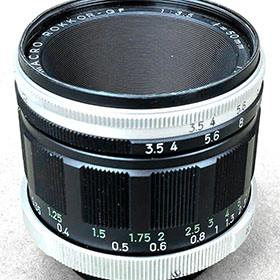
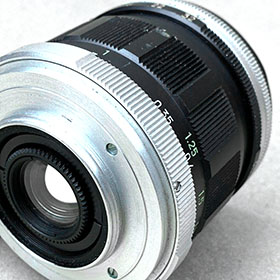
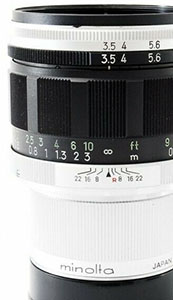
(Detail from larger web images)
I don't know how infinity focus with/without the adaptor works on an LTM body.
Minolta G-Rokkor 28 mm f/3.5
The release of a new LTM lens may have seemed like an odd thing to do in the 1990s. It certainly wasn't done with the intent of adding to the Minolta 35 lens portfolio in mind, that was already a 40 year old camera by then. In fact, it was a limited edition hero lens released to celebrate the 70th anniversary of the founding of the company in 1928. Minolta may have been thinking of the Leica M mount but may not have had a license for that beyond the Leica CL and Minolta CLE cameras of the 1970s, however, LTM is fully adaptable to M mount. Total production was 2,000 lenses.
| Focal length | 28mm |
| Design | 5 elements/5 groups |
| f stops | f/3.5 - f/22 |
| Aperture blades | 9 |
| Filter thread | 40.5mm |
| Dimensions (dia. x length) | 51 x 19.5mm |
The LTM version of the lens is optically the same as the the version that appeared on the high grade compact fixed lens Minolta autofocus camera, the Minolta TC-1. LTM lens:
 (Detail from larger web image)
(Detail from larger web image)
Finders
Each of the wide angle and telephoto accessory lenses made for the Minolta 35 (i.e., what I have called first and second edition lenses) was supplied with a dedicated finder for that focal length. They all followed a similar style, the left one is for the 8.5 cm telephoto and the right two are for the 13.5 cm telephoto and 3.5 cm wide angle lenses.

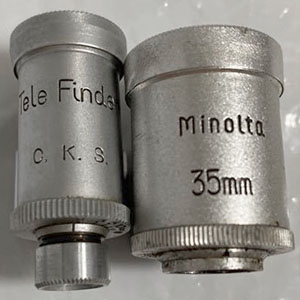
(Detail from larger web images)
Accessories
Lens caps and leather ever-ready/lens cases were supplied with the camera and accessory lenses, the other items are extras.
Lens Caps
There were two main styles of lens caps, the early type (left below) used until the end of the Model F and into early Model II production and the late type that was introduced with the Model II (right below), perhaps with type a2 when the f/2 lens first appeared, that can be found in sizes to suit the 45 mm lens (middle below) and f/2.8, f/2 and f/1.8 5 cm lenses:
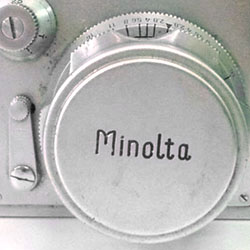

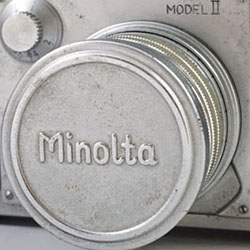 (Images 1 & 3, detail from larger web images)
(Images 1 & 3, detail from larger web images)
The early type features a typically Leica style with raised centre panel, the name engraved and in the case of the Minolta, filled in with black. The later type features a raised ring and raised lettering.
Typical rear cap for accessory lenses:
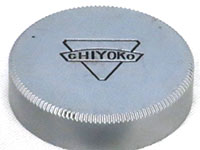 (Detail from larger web image)
(Detail from larger web image)
Ever-ready and Lens Cases
There were four main styles of ever-ready cases over the life of the Minolta 35, the first three very similar and influenced by Leica practice as much as the other copy makers were. All were leather.
Early style served from Model A to Model II types a1 & a2 (Model D and later models featured half case cut outs for the strap lugs):
 (Detail from larger web image)
(Detail from larger web image)
Some early Model II examples feature a slightly updated design, mainly limited to “Minolta” in a new italicised font and a radiused corner where the vertical of the front piece meets the horizontal of the lid part:
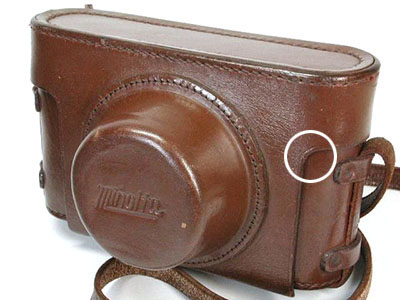
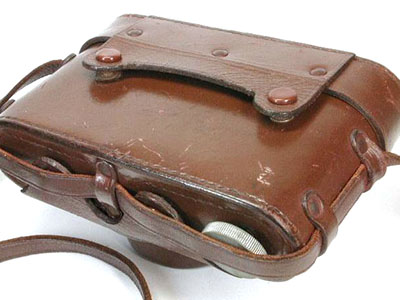
(Detail from larger web images)
However, almost at the same time, these earlier versions were replaced by one of similar appearance but with the original style “Minolta” name and a new chrome dress rim on the nose and an embossed ridge across the top piece. The shoulder strap which used to pass through two leather saddles at each side of the case and under the camera now featured two ends which were riveted to the case just below the remaining top saddles. This type appeared as early as the Model II type a2:

(Detail from larger web image)
The Model IIB case featured an updated, more moulded shape with chrome trim across the top, the snout mounted from under the the top case leather instead of on top of it and pivoting metal D rings for the shoulder strap attachment points:
 (Detail from larger web image)
(Detail from larger web image)
Accessory lens cases were leather too and fairly typical of the 1950s generally. There were minor differences between models and over time. The case on the left is for an early f/2.8 8.5 cm lens. The case on the right is for an f/3.5 3.5 cm wide angle lens which arrived around 1956. It is very similar to but taller than another wide angle case, I wonder if the difference is because this one is designed to accommodate the finder whereas the other looks too short:
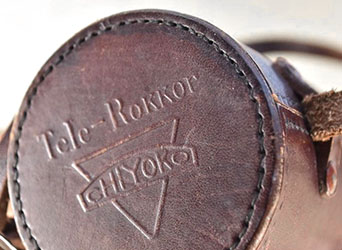

(Detail from larger web images)
Filters
Both the Model E and Model II user manuals refer to a set of 3 in a celluloid case, type not specified. The two photos on the left are one set and the photo on the right is another. Both were for sale with the last type f/2.8 45 mm lenses and both are yellow, orange and green filters for monochrome film:
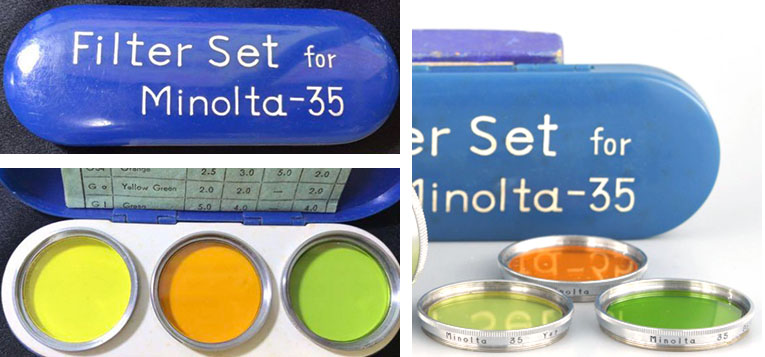
(Details from larger web images)
It seems that they were also sold separately, this is one of three boxed filters for the Model II 5 cm lenses with 40.5 mm filter thread (5 cm f/2.8 and early f/2) being sold together:
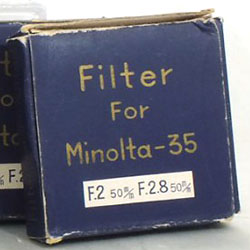
Below is large framed example (not one of the boxed ones, they seem to have a more petite frame) of a 40.5 mm type:
 (Detail from larger web image)
(Detail from larger web image)
Over the years there were many versions and styles of “Minolta” branded filters, for collectors trying to match the Minolta 35 vintage, the key feature is the style used for the name.
Lens Hoods
Hoods for Standard Lenses
Hood with 34 mm thread mount for f/2.8 45 mm lens:
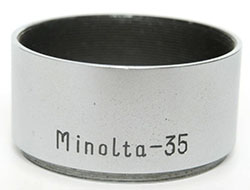
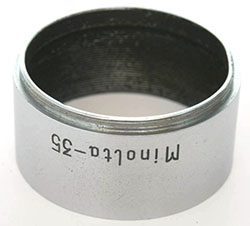 (Detail from larger web images)
(Detail from larger web images)
Two views of a screw in type for the f/2.8 5 cm lens even though it looks like a clamp type (the “f 2.8” can just be seen on the mounting ring). The photos below give the impression of it being slightly tapered, other photos confirm it to have parallel sides like the f/2 version:
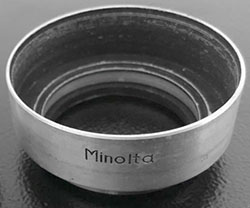
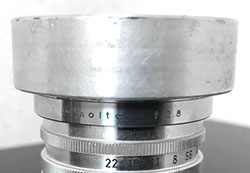 (Detail from larger web images)
(Detail from larger web images)
Very similar version for the f/2 5 cm lens (the “f 2” can just be seen on the mounting ring). This hood was being sold with a set of three boxed Minolta 35 filters (example above) marked “F.2 50 m/m F.2.8 50 m/m” meaning that they were suitable for the 40.5 mm filter thread used on the f/2.8 lens but also on the early version of the f/2. Presumably, this hood is also for the earlier version of the lens with 40.5 mm filter thread so why/how is it different to the f/2.8 version? One explanation is that the only difference is the marking of the two hoods - when the f/2 was released with 40.5 mm filter thread, there was no f/2.8 5 cm lens yet and the f/2.8 hood may be from a time when the f/2 had already changed to the 43 mm filter thread:
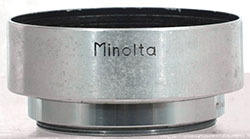
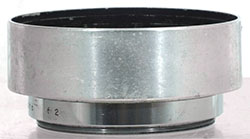 (Detail from larger web images)
(Detail from larger web images)
The new f/1.8 5 cm Model IIB lens features a black screw in hood with chrome base. The image on the right shows one screwed into a filter. Like the IIB box further down, the “Minolta” name is in the older style rather than the new style introduced on the Model IIB itself:
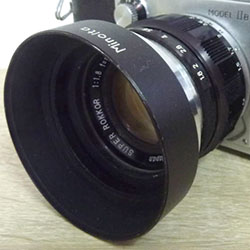
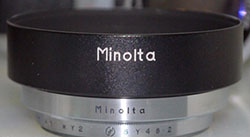 (Detail from larger web images)
(Detail from larger web images)
Hoods for Accessory Lenses
Screw-in type for 8.5 cm telephoto:
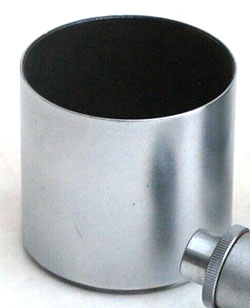
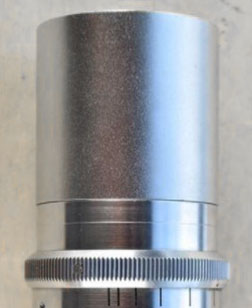 (Detail from larger web images)
(Detail from larger web images)
Screw-in type for 11 cm telephoto:
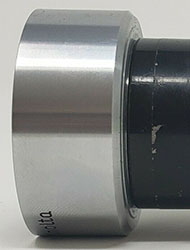 (Detail from larger web image)
(Detail from larger web image)
Clamp type for 13.5 cm telephoto showing clamp and also mounted:
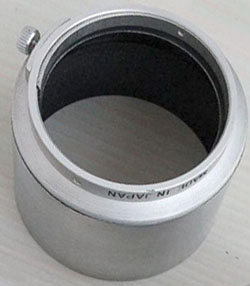
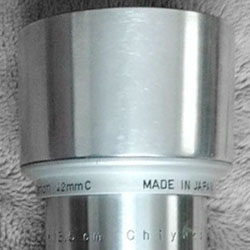 (Detail from larger web images)
(Detail from larger web images)
Reloadable Film Cassettes
The Minolta 35 Model II introduced a new back locking mechanism. Whilst it reduced the risk of accidental opening, it also introduced a means of using mechanically opened and closed reusable film cassettes which had been in use by Leica and Leica copies and other cameras including SLRs. Whilst reusable cassettes provide economy through bulk loading, the advantages of a mechanical system over a reusable or single use felt light trap type are lower friction and lower risk of scratching the film.
Most mechanical cassettes offered by camera makers followed either the Leica design or the later and more elegant Zeiss design (Leotax changed from Leica to Zeiss inspired) but generally, even if the cassettes looked like the original or like some others, they only work in the specific brand of camera they were made for. On the other hand, the felt trap type are more like single use cassettes and are generally universal. It is not known if Chiyoda Kōgaku offered a branded version of this type for earlier Minolta 35 models or not but there is no mention in the Model E user manual or other documents.
There are Japanese ads from the 1950s featuring after-market cassettes by suppliers of both the universal felt light trap type and also the mechanical type made for specific camera brands including the Minolta 35. The two examples of the mechanical type below were for sale with boxed Model II type a1 and a2 cameras from different sellers but there are no markings visible on either to indicate whether they are Chiyoda Kōgaku branded or after-market. Because they look identical, I think it is at least very likely that the maker was the same and I think that also increases the chance of them being Chiyoda Kōgaku supplied items:
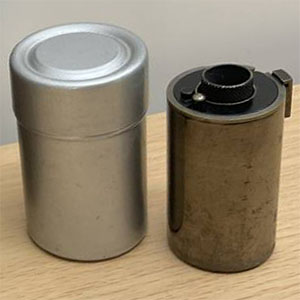
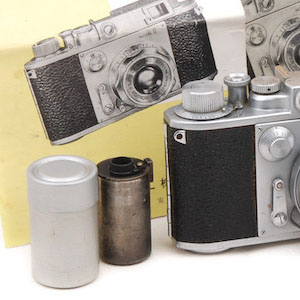 (Details from larger web images)
(Details from larger web images)
Operation of the cassette is covered on pages 4, 10 and 11 of the Model II user manual downloadable from Flynn Marr Photography and other sources mentioned further above. Page 10 below:
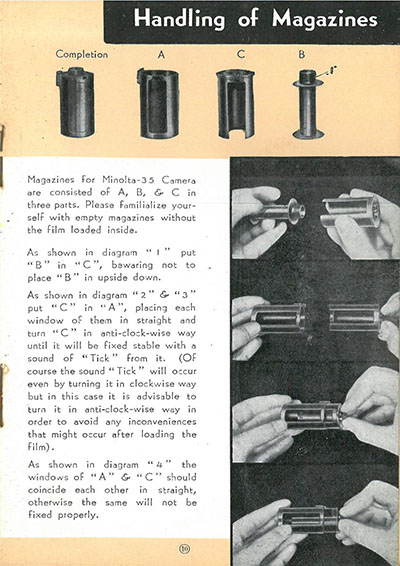
Minolta Auto-Up Close-up Lens & Rangefinder Attachment
Although almost certainly not Chiyoda Kōgaku made, it offered an auxiliary close-up lens, which screwed into the front of the standard lens, together with an accessory shoe mounted viewfinder/rangefinder compensating lens in a rectangular frame allowing those devices to be used normally. This was named the “Minolta Auto-Up”, boxed set below sold with a Minolta Model II type a1:
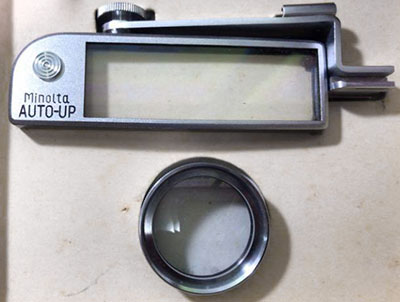
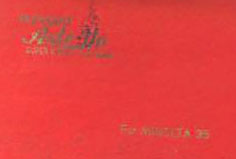
(Detail from larger web images)
The gold text on the box lid is hard to read, the big text in the left hand corner says “Auto-Up” and the text in the bottom right corner is “For Minolta 35”. There was also an Auto Up for the Minolta A-2 fixed lens rangefinder camera and possibly for other models too. The image below is from the accessories page of the Japanese Minolta 35 II type b2 user manual. Whereas the above Auto-Up frame mounts via the accessory shoe, this one uses a lens mount. I haven't seen it mentioned in earlier documentation, although the camera depicted is a type a2 (earlier body but f/2 lens already):
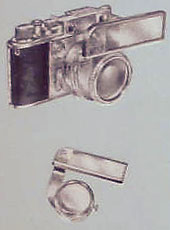
The best known and promoted Auto-Ups are Canon Auto-Ups which look the same as the Minolta version, the Konica version, the Mamiya version etc. and those made to fit Leica cameras, Contax IIA, Retina IIa etc. There is a Nikon version too which looks a bit different. The inventor is a Mr Shimada, who was issued patent 174601, and who commercialised the device under the “Pleasant” brand name. There is more on the Canon Lenses, Flash & Accessories page.
Flashguns
See also Flash Synchronisation further above.
The earliest flashgun was the Minolta Flash-Unit Type U which used the central pressure ball in the accessory shoe as an early form of hot shoe connector:

(Detail is from a larger image on the flashgun box featured on Camera-wiki.org)
The camera pictured is either a Model A, B or C.
Below is a page from the English language Model E user manual (available for download from the Minolta page of the Pacific Rim Camera website), circa 1951, which shows two available flashguns, Minolta Flash Unit Ub and Minolta Flash Unit B.C.B.:
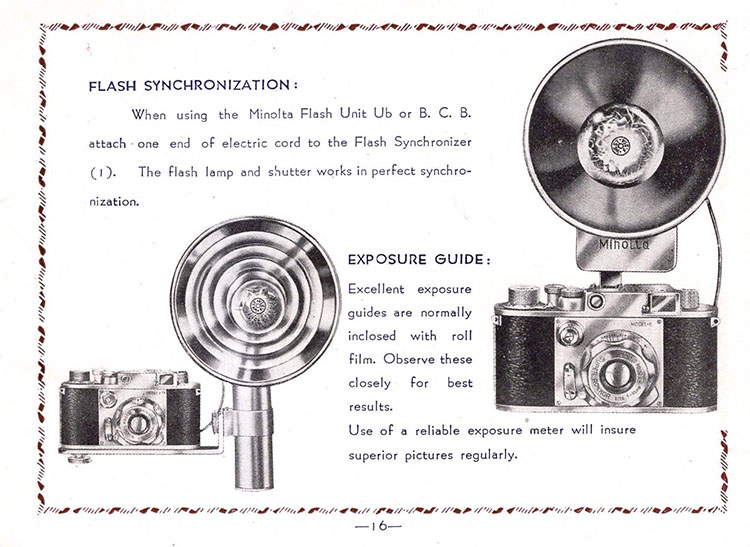
The Ub seems to be similar to the earlier Type U except that it connects by sync cord (type unknown). The energy source is likely to be 4 penlight batteries (AA). The B.C.B. will certainly feature a capacitor and probably a 22.5 volt battery.
The Model II type a2 user manual refers to “Minolta B.C. Model & Minolta Penlite Model E”. The Model II was the first to feature a PC connector.
The Japanese Model II type b2 user manual features the “Minolta Junior B.C.” flashgun, below top left (also the model depicted in the Japanese Model IIB user manual). The English language user manual for the flash can be downloaded from Massimo Scotti's website and confirms that the flash in the camera user manual and my example pictured in the other images are of the same model. An auction seller claims that the flash is from 1956, although it continued to appear in various other Minolta user manuals until at least 1960. Note the sync cord with two pin connector to the flashgun and the dual connector on the other end, one of which is a PC type, the other is described as “American” type but in later manuals is named as an ASA plug (the ASA plug was unlikely to be intended for any Minolta models, more probably the flash was simply offered as a universal type to also suit many other cameras in the US market - see also comment below):

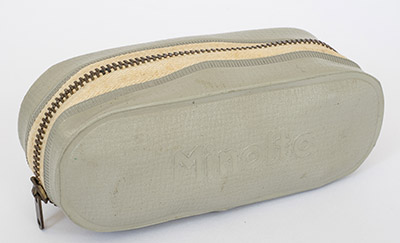
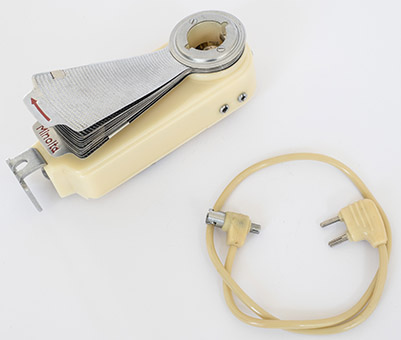
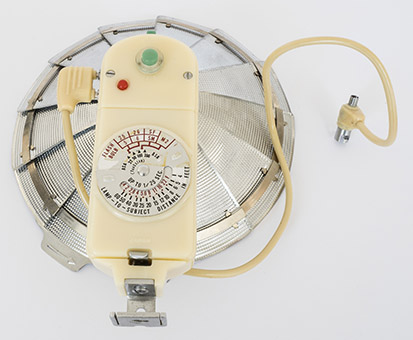
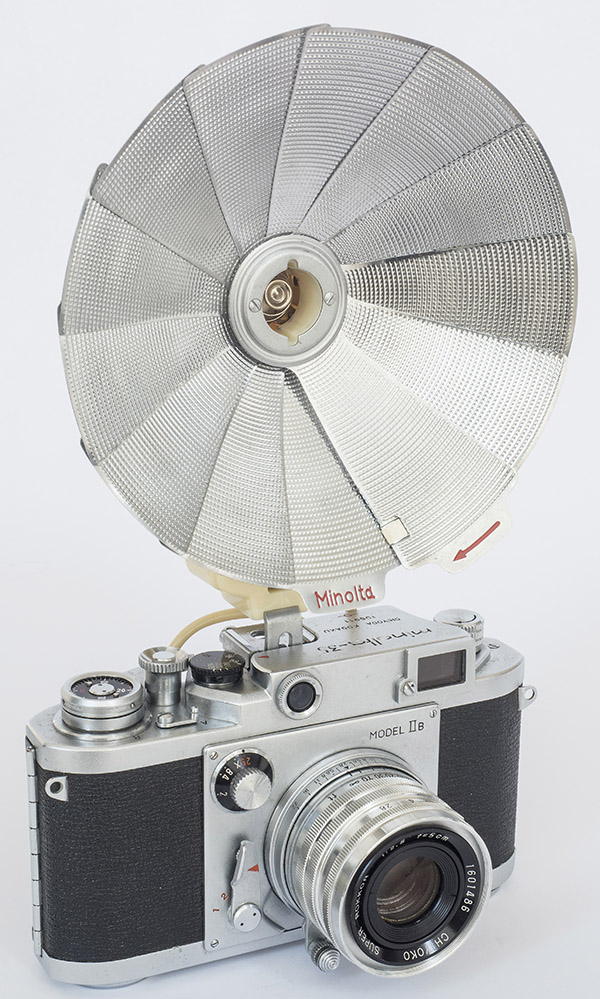
Interestingly, there are internal and external elements of this flashgun, including the sync cord plug moulding detail and two pins and dual connector, which are very similar to the Miracle Power Model O made by West Electric Co., Ltd., maker of Nicca and early Nikon flashguns and from 1958, associated with Matsushita, now Panasonic Corporation. The fanfold reflector is also very similar to several West models.
The Model II type b2 user manual description translates as follows:
“Minolta Junior B.C. Flash
1. Although it is ultra-compact for the pocket, it has the highest performance as a flash because it uses laminated batteries.
2. The main body is made of plastic and the folding reflector has 13 aluminium segments. It is a very smart and lightweight flash with a base attached.
3. You can also use it with two AA batteries. (At that time, change the terminal position of the flash).
4. There is a test lamp to check the flash bulb and the battery state, so failure due to a defective flash bulb or battery is not possible.
5. The used flash bulb can be automatically ejected by pressing the button on the top of the flash, so there is no risk of burns.”
Enlarger
Although better known for the Minolta Color models of the 1970s and 1980s, Chiyoda Kōgaku sold enlargers in the 1950s too, the one promoted in the Model II type a2 user manual is the “Pennant 6 x 6 Model fitted with enlarging lens E. Rokkor 50 mm or 75 mm”, the 50 mm being most suitable for 35 mm negatives and the 75 mm being for 6 x 6. Image from page 17 of the user manual:
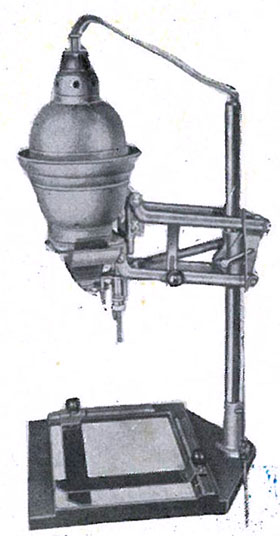
There was also the Mini 16 3 in 1 Enlarger which was available with negative carriers for 35 mm, 16 mm and 9.5 mm and with a 30 mm lens for 35 mm negatives and a 25 mm for the smaller formats.
Slide Projector
Chiyoda Kōgaku made a well-built small slide projector which appears in the 1957 company brochure mentioned earlier (downloadable from the brochures page of French Minolta site, minolta.suaudeau.eu). A 1963 company booklet in Japanese dates it to Showa 28 - 30, 1953 - 1955, I would say probably 1955. It seemed to have initially been simply called the “Minolta Mini” projector. It became the “Minolta Mini 35” (there were also a “Minolta Mini 44” version for 127 super slides and a “Minolta Mini 16” for sub-miniature 16 mm film released in the Showa 31 - 33 period, 1956 - 1958) and culminated in the “Minolta Mini-35 II” in the early 1960s. Convection cooled and manually operated in standard guise, a “Minolta Blower” was available, basically an electric fan in a base which sat under the projector, and also a “Minolta Autochanger” - there were both earlier and Mini-35 II versions of these. The Autochanger wasn't that auto but it was far more convenient than inserting and removing slides one by one.
They must have been quite popular, they are relatively common on Japanese auction sites. This may be the first type below from the time of the Minolta 35 Model II:



(Detail from larger web images)
Note. Image 3 is the operating position but neither the manual slide changer nor Autochanger are mounted.
From Chiyoda Kōgaku to You - Boxes
Collectors like boxed examples. The Minolta 35 was still from that time when boxes were a bit sumptuous and made a statement, something that you might hold onto to store your camera. The three dark blue velvet feel boxes below were all found with Model II examples, the first, without lens identification belongs to an early version with the f/2.8 45 mm lens, the other two to examples with the lenses as marked on the boxes:



(Detail from larger web images)
The Model IIB signalled a change in sentiment. The box was given a more modern look and no doubt cost less to produce - by the mid to late 1950s, interchangeable lens rangefinder cameras were struggling to find sales and Leotax and Nicca went down the same path with their boxes. The “Minolta” name is still in the old style, not the all lower case new one:
 (Thumbnail from the web)
(Thumbnail from the web)
Other Minolta 35 mm Interchangeable Lens Rangefinder Cameras
The Minolta 35 was Chiyoda Kōgaku's/Minolta's only camera that featured the Leica thread mount and closely matched the Leica's specifications, if not features, but it certainly wasn't the company's only 35 mm interchangeable lens rangefinder camera. There was the prototype SKY, a bayonet lens mount spiritual successor to the Minolta 35 like the Leica M3 was to the Leica IIIf, two different A series cameras and Minolta's collaboration with Leica on compact M mount cameras in the 1970s.
SKY and Model III Prototypes
This camera is known as the “SKY” which is an acronym made up from the first letters of the Japanese term “shashin kikai yarikake” which translates as “photographic instrument in progress” (Camera-wiki.org), or in other words, “prototype camera”.
This camera was inspired by the Leica M3, featuring a viewfinder with parallax correction and automatically selected frame lines for 50 mm, 90 mm and 135 mm. The focal plane shutter featured a top speed of 1/1000 and a single setting dial. The lens mount was a bayonet type designed by Chiyoda Kōgaku. As many as ten lenses were planned.
Whilst it has been suggested that a pre-production run of 100 cameras was made, the only known camera to exist has serial camera 100001. According to Camera-wiki.org, the 100 examples were presented to Minolta employees and executives in March 1957 - if they existed, there is no evidence that any have turned up anywhere since. There is more information, photographs and drawings on Mike Eckman's excellent review of the Minolta Super A. The photo below is a low resolution version I have borrowed:
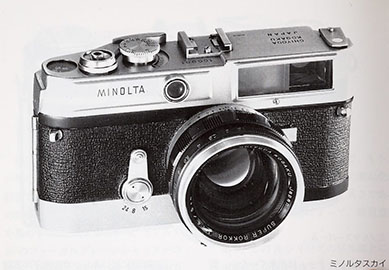
A number of reasons have been postulated for the abandonment of the seemingly production ready camera from Leitz's displeasure (as mentioned above, it wasn't an M mount) to the impending release of the SR-2 SLR. The reality probably was that Chiyoda Kōgaku realised that the market was no longer there. Maybe the company needed some assistance to come to that realisation, the story is that founder and company President, Kazuo Tashima, on a visit to the USA, proudly carried onto the aeroplane an example of the SKY, perhaps the one above, slung around his neck. On his return, it travelled in a box.
A Japanese blog site features these two photos (I have substituted a slightly larger version of the right image from Massimo Bertacchi's site which mistakenly refers to it as the SKY), the left one of the 1957 SKY and the right which the blogger claims is the 1958 Minolta Model III, a simpler version meant to replace the Model IIB:

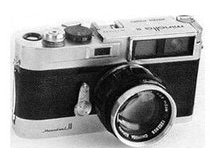
Presumably it still features a Leica thread lens mount, the lens possibly being the Model IIB f/1.8 5 cm standard lens whereas the SKY is usually pictured with an f/1.4 lens. The two bodies appear to be very similar, the obvious differences being the rectangular rangefinder window in place of the round one, a simpler rewind crank, detailing around the otherwise similar automatic frame counter window, the top plate reshaped around the accessory shoe, style of names and the IIB-like black shutter speed dial on the Model III. The name on top seems to say “Minolta 35” in the new 1958 style of the Model IIB and the name bottom left might be “Model III”.
It may have been an exercise to see how the costly development work on the now abandoned SKY could be monetised, or it is possible that it was just a different version of the SKY prototype - we don't know what name that was going to be released under.
Minolta A Series
There were two interchangeable lens Minolta A series cameras but first, the background.
Chiyoda Kōgaku released its first fixed lens leaf shutter 35 mm camera in 1949. This was the Minolta Memo, a simple yet innovative bakelite bodied model without rangefinder. In 1955, it followed up with the Minolta A. This was a more substantial die-cast model with rangefinder but like the Memo, it did things differently. It was still a budget model with an f/3.5 lens and shutter speeds to 1/200, later 1/300. The body was quite thick in the middle and the ends tapered giving it a tubby appearance. The reason for this is that the leaf shutter assembly is mounted backwards behind the lens, i.e. with the mechanism facing the film (there is a separate aperture mechanism with the blades in the usual place in between lens groups). Most leaf shutter cameras mount the shutter in the lens, i.e. the front lens group/s mount in front of the shutter blades and the rear group/s behind. Because the shutter speeds could not be set like on a normal rim set shutter, the speeds were set by a rolling thumb wheel on top of the camera.
Also launched in 1955 was a higher spec version, the Minolta A-2. This featured a parallax correcting bright frame viewfinder, a higher spec shutter with self-timer and, at some point, the option of an f/2.8 lens but was otherwise similar. Below is a low resolution version of an ad for for both models featured in Modern Photography from Mike Eckman's review of the Minolta A:
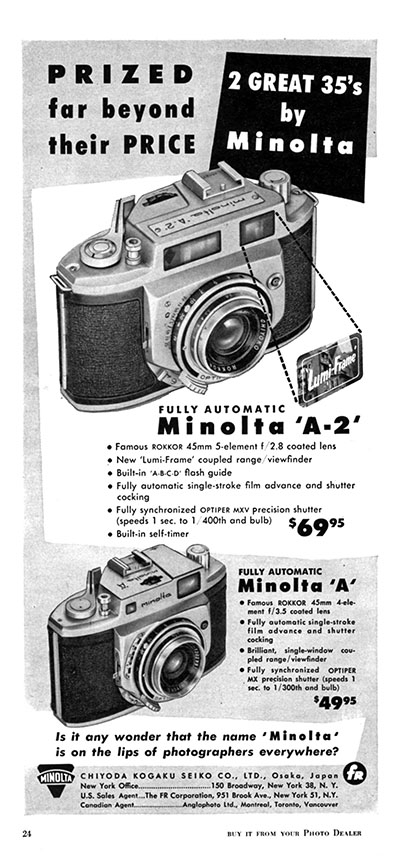
Perhaps only coincidental, beyond their shared Rokkor lenses, there are eerie similarities conceptually between the shutter arrangements and lens mount/focusing systems of the A series cameras and the earlier Look camera from 1949 (or 1952-3, depending on source) mentioned on the Leica Copies page.
Minolta A-2 LT (some say A-2 L)
Most probably launched in 1958, this is an A-2 with interchangeable lens mount. The only noticeable external difference to the plain A-2 is a post below the sync socket which provides an external connection to the second helical of the f/4.8 100 mm telephoto lens, the only accessory lens offered. As well as the bright frame for the f/2.8 45 mm standard lens, the viewfinder shows the corners of the telephoto coverage area . The mount is a unique 24 mm type.
Everything else about the camera, including the “Minolta A-2” name on the top plate, is the same as the standard A-2. Most sources refer to the model as the “Minolta A-2 LT”. The Sub Club website claims that is a mistake and that the correct name is “Minolta A-2 L”. Swiss collector, Renaud Laemmli, explains more completely on Sylvain Halgand's Collection Appareils site that since World War II, Chiyoda Kōgaku/Minolta used an internal code number system for nearly all items produced. He may be referring to the spreadsheet display of those code numbers collected by Minolta expert Andrea Aprà. According to the the code numbers listed in the spreadsheet, the “Minolta A-2 LT” is the telephoto lens for the camera and the camera body, including standard lens, is the “Minolta A-2 L”. Whilst I'm not disputing that, Chiyoda Kōgaku seemed to really emphasise the “A-2” part of the name, e.g. the supplementary instructions for mounting and using the 100 mm lens only mention “A-2”, no “L” or “LT”. Having said that, here is a page from a Chiyoda Kōgaku multi-model Brochure from 1958 (also features the Minolta 35 Model IIB and Minolta SR-2 SLR) and it clearly labels the camera “Minolta A-2 LT” (OK, the hyphen is in an odd place in one place and missing in another):
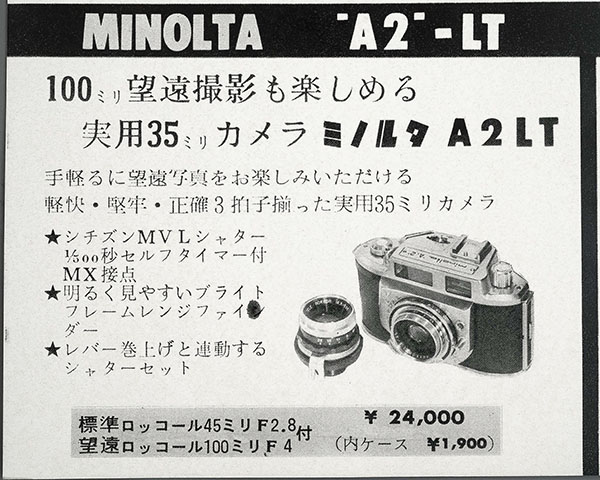
However, rather than the camera being called “Minolta A-2 LT”, perhaps it means “Minolta A-2 with LT (lens)”?
Also, according to the code numbers in the spreadsheet, the camera was launched in 1957 and the telephoto lens in 1958 but as they were sold as a package, that might suggest that the early code numbers are not entirely reliable, or there is something lost in translation.
The price of ¥24,000 included both the f/2.8 45 mm lens and f/4.8 100 mm lens (brochure says f/4, a mistake) with the ever-ready case ¥1,900 extra. That is a bargain compared to the standard A-2 price of ¥19,800 in a brochure from a couple of years earlier.
Perhaps introduced as a cheaper alternative to the Super A (see below, priced at ¥33,800 with standard f/2.8 lens only in the same brochure as the A-2 LT) into a Minolta interchangeable lens segment which would become very crowded with the Minolta SKY development and the Minolta 35 IIB (priced at ¥42,800) and the SR-2 SLR about to be introduced, its life was extremely short making it a very rare camera:
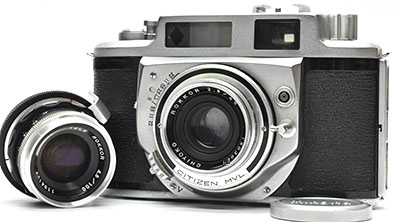 (Detail from larger web image)
(Detail from larger web image)
Minolta Super A
Whereas the A-2 LT was an A-2 with interchangeable lens mount added, the Super A was an A-2 on steroids launched in 1957. The concept was similar, using the same inverted shutter design but the body was all new with a superior build quality. It featured interchangeable lenses with a mount described as bayonet, but more like a breech lock system, with the focus helical mounted in the body so that lenses didn't require their own focusing system. The leaf shutter was a Seikosha MX with 1/400 top speed. The frame counter featured automatic reset and a film speed reminder was added to the top of the film wind lever. Film rewind was by folding crank instead of knob. On the back was a DoF calculator for different lenses.
Three standard 5 cm lenses were offered; f/2.8, f/2 and f/1.8. Accessory lenses were available in a range broadly comparable to the Minolta 35; f/3.5 3.5 cm, f/2.8 8.5 cm, f/3.8 10 cm and f/4.5 13.5 cm. The viewfinder only featured a projected brightline for the 5 cm length, although the full frame corresponded to the 3.5 cm lens field of view, helpfully confirmed on the black plastic cover plate on the back (there are claims on the Internet that the viewfinder is parallax compensated - not so according to Mike Eckman).
This is from the same Chiyoda Kōgaku multi-model Brochure from 1958 as the A-2 LT page above:
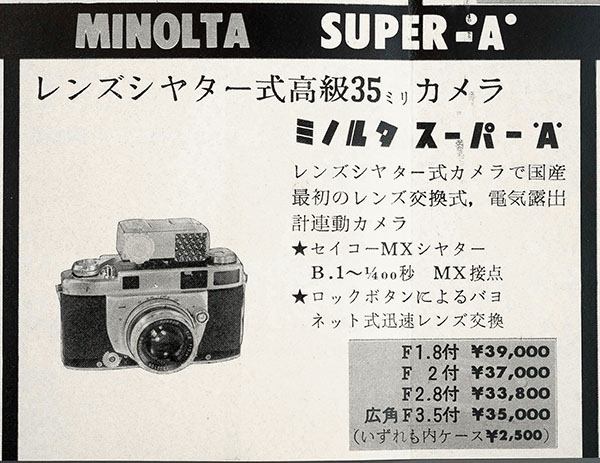
Three photos of a slightly tired Super A and two views of the f/3.5 3.5 cm wide angle lens showing the bayonet receptacles on the main part of the lens body:




(Detail from larger web images)
There was also an optional exposure meter, called the “Minolta-meter”, which mounted in the accessory shoe and coupled with the shutter speed thumb wheel:
 (Detail from larger web image)
(Detail from larger web image)
It was supplied with an incident light measurement panel to fit over the selenium cell and also a light amplifier attachment. A photo of the mounted meter, attached amplifier and incident screens for both meter and amplifier selenium screens is on Camera-wiki.org.
There is more Super A information and photographs on Mike Eckman's review.
Chiyoda Kōgaku seemed to be uncertain about how its Minolta 35 should fit into the market place. In 1947 it was well built and innovative, a competent camera, but not necessarily something that a professional or advanced enthusiast would aspire to. It seemed to be more for the advanced amateur that wanted the flexibility of being able to change focal lengths who also appreciated the convenience of the opening back for film loading, the simplicity of a single viewfinder window and the ability to take “selfies”, in those days, more likely for the photographer to include themselves in group shots of, e.g. families. All at a reasonable price in comparison to other options. By its demise, it was falling behind the competition. The SKY prototype showcased what Chiyoda Kōgaku was capable of if it wanted to play with the big guys like Canon and Nikon but it seems to me that it thought that the market the Minolta 35 was intended for was now more likely to be better served by cameras like the A-2 LT and the Super A. These brought updated features, even a coupled meter and the leaf shutter and lenses were cheaper to produce making the camera more affordable for the masses. Compared to the Minolta 35, the only downside of the Super A was the marginally lower 1/400 top speed vs 1/500. Of course, that is from the company's viewpoint. From the purchaser's perspective, you still couldn't buy a model with 1/1000 shutter speed and were tied to Chiyoda Kōgaku's lenses made for this model and who knew how long the commitment to the mount would last. In fact, not very long at all but the bigger issue was the ascendency of the SLR.
As evidence of this thinking, the Minolta 35 seemed to more and more play second fiddle in advertising to all the Minolta A series cameras and then disappeared almost completely from view. An official Minolta products brochure in French shows photos of both the A series models and the 35 but puts horizontal lines through the 35 with the name and specifications left blank except for the statement, “remplacé par Super A” meaning “replaced by Super A”. The model depicted was the 35 Model II type b (b1 or b2), not the 35 Model IIB which was still to make its debut:

The full brochure is downloadable from the brochures page of French Minolta site, minolta.suaudeau.eu.
The Leica M mount Cameras
Leica CL/Leitz Minolta CL
In June 1972, Leitz entered into an agreement with Minolta to jointly develop and share products. The first product was the Leica CL M mount compact rangefinder camera released in 1973. In the Japanese market, it was named Leitz Minolta CL. The front mounted shutter dial, metal around the lens mount and lens release button with the red circle look like retro design cues from the Minolta 35, whether intentional or not (the lens release button is roughly in the same place as the similar appearing Minolta 35 Model F and later self-timer knob):

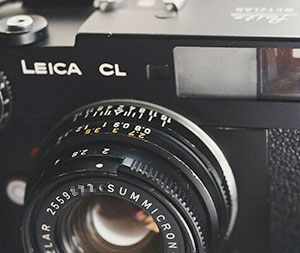
(Detail from larger web images)
This took the Leica M concept and shrunk it into a compact body with a compact Japanese price to match. It was designed for advanced amateurs rather than professionals who had been deserting the larger M series for the Nikon F and Canon F1 SLR cameras in droves. The cloth focal plane shutter with 1/1000 top speed was vertically running. There was a built-in through the lens exposure meter with the CdS cell on an arm which moved out in front of the film for reading and then moved out of the way just before the shutter fired. Exposure was manually set. The parallax corrected viewfinder featured an always visible 40 mm bright frame line and automatic 50 mm and 90 mm frame lines. However, the rangefinder base of 31.5 mm and magnification of 0.6 results in an effective base length (EBL) of 18.9 mm compared to the comparable Leica M5 of 49.32 mm. So not so great for longer and bigger aperture lenses but that was never its intent.
There were two dedicated lenses, the f/2 40 mm Summicron and f/4 90 mm Elmar. Whilst many other M mount lenses could be used and vice versa, there were varying degrees of issues including with automatic frame lines, lenses covering the viewfinder and bulging rear elements interfering with the metering arm.
It was killed off by Leitz three years later in 1976 as “not commercially successful” despite outselling its larger siblings.
Minolta CLE
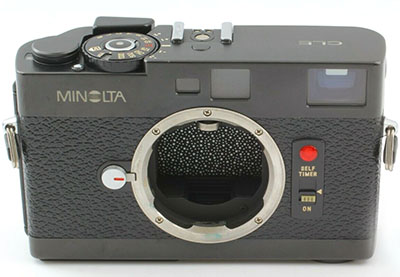 (Detail from larger web image)
(Detail from larger web image)
The Minolta CLE was made from 1981 to 1985. It was an updated CL concept but this time without the Leitz partnership. The shutter was now an electronically controlled cloth focal plane type travelling horizontally with a top speed of 1/1000. It featured both aperture priority automatic and manual exposure control with the meter reading taken off the film. The viewfinder had projected bright line frames for 28 mm, 40 mm and 90 mm lenses to match the three dedicated lenses that were made for the camera; the Minolta M-Rokkor f/2.8 28 mm, Minolta M-Rokkor f/2 40 mm and Minolta M-Rokkor f/4 90 mm.
It also had a better EBL of 28.77 mm (base length of 49.6 mm x 0.58 magnification) compared to the CL EBL of 18.9 mm.
Contact Details
My name is Paul Sokk and I can be contacted by email at paulsokk@live.com.au.
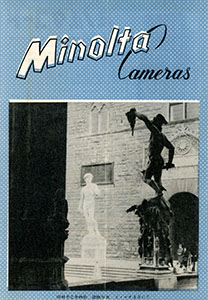
.jpg)
